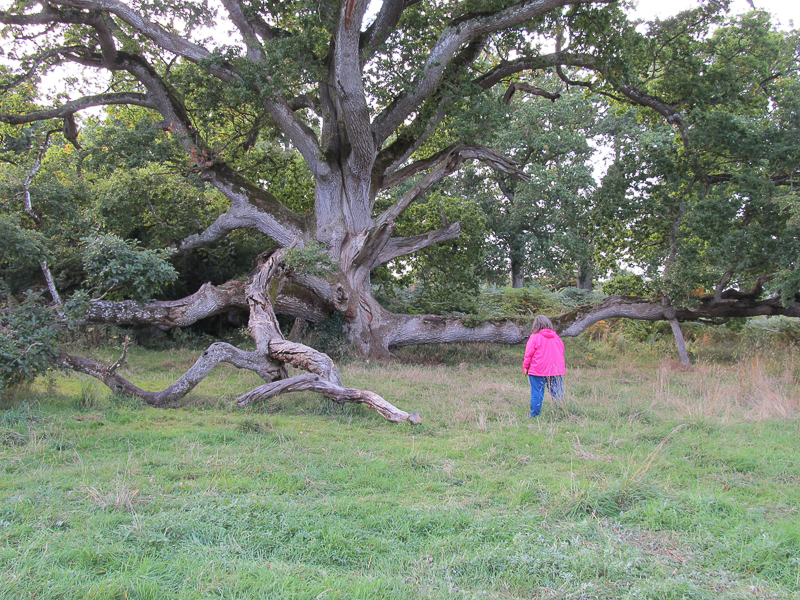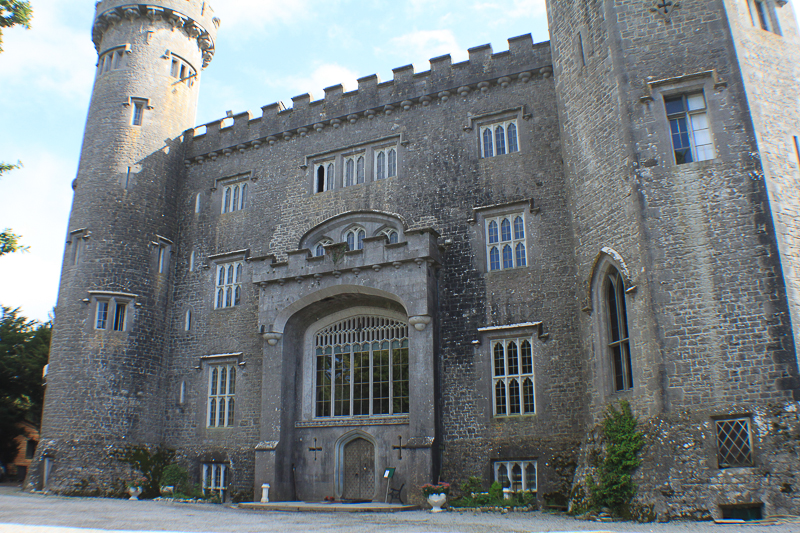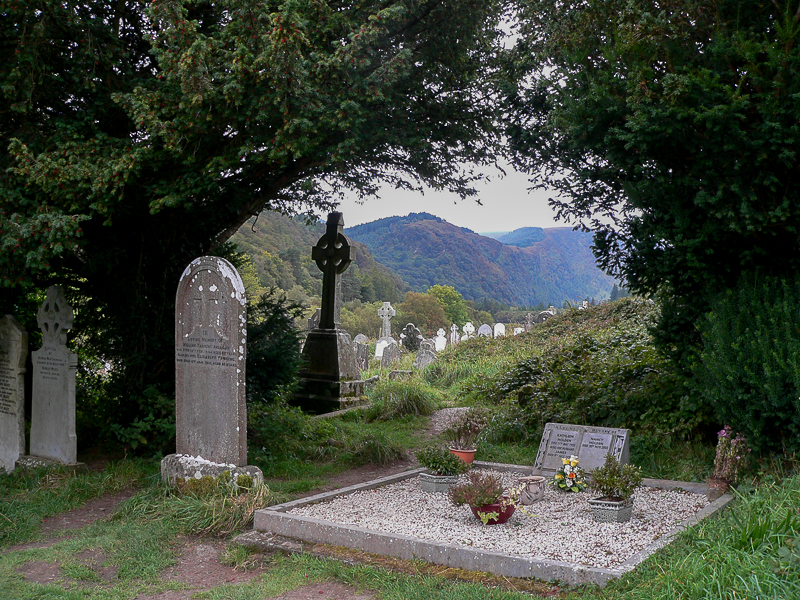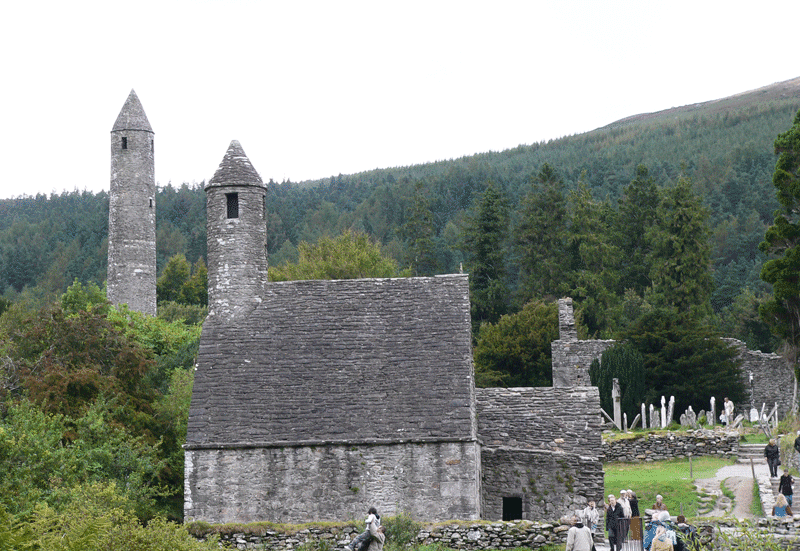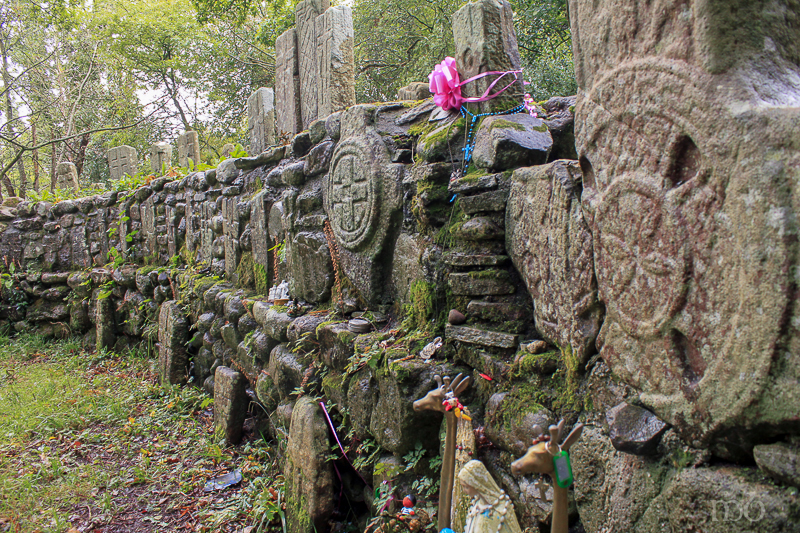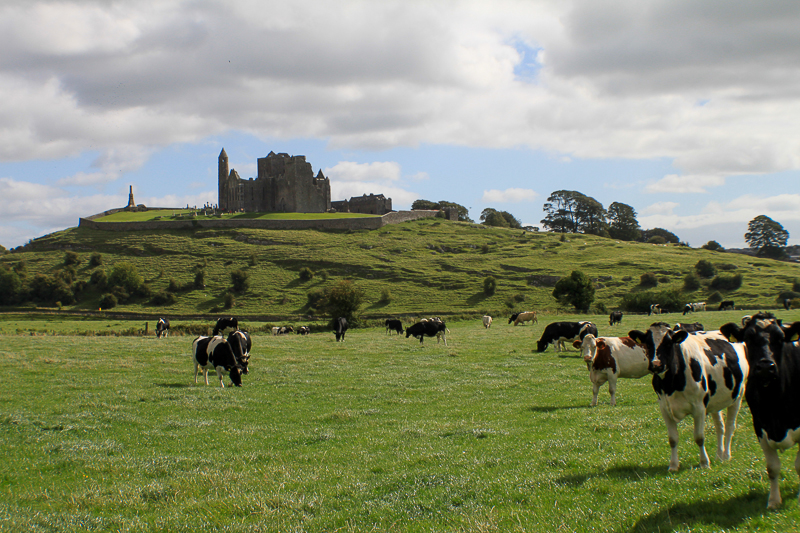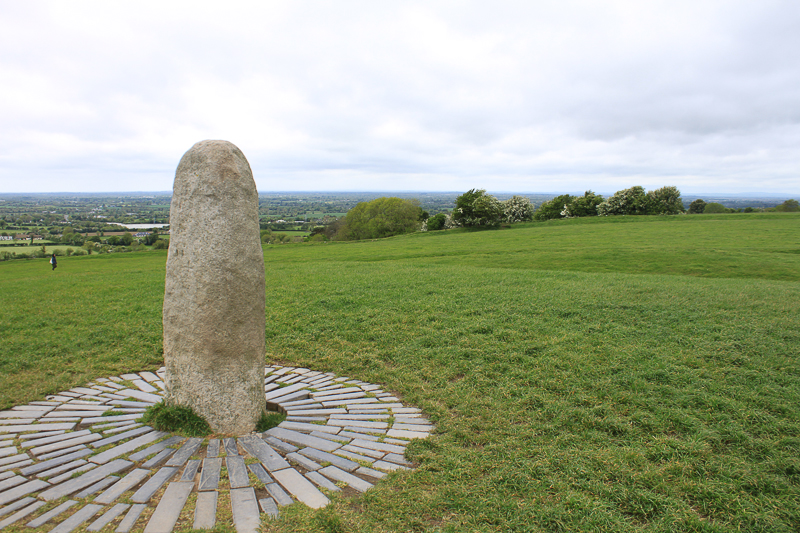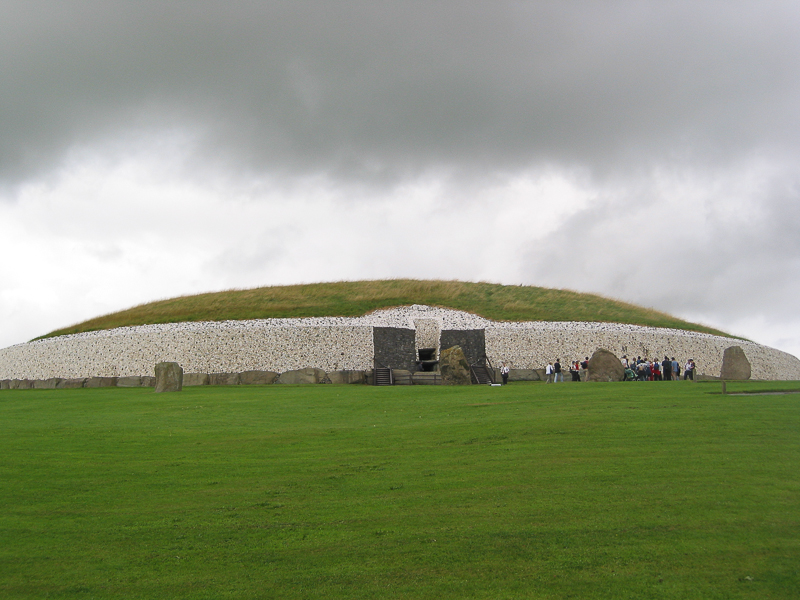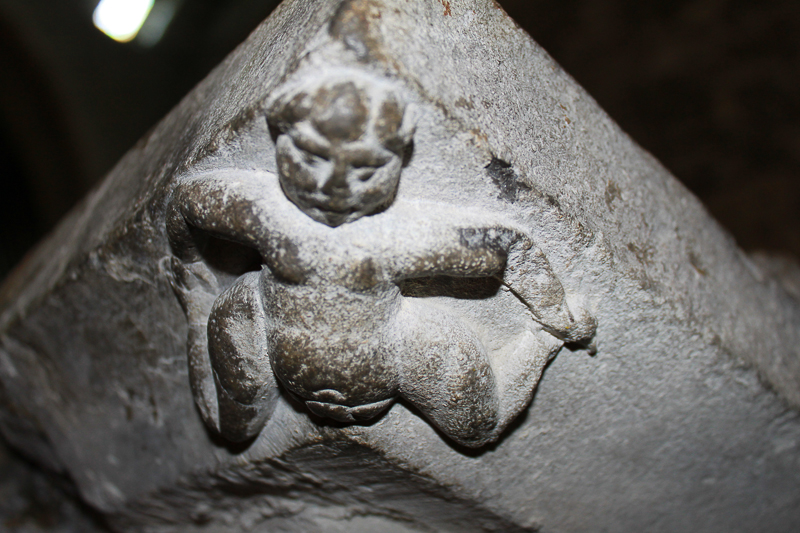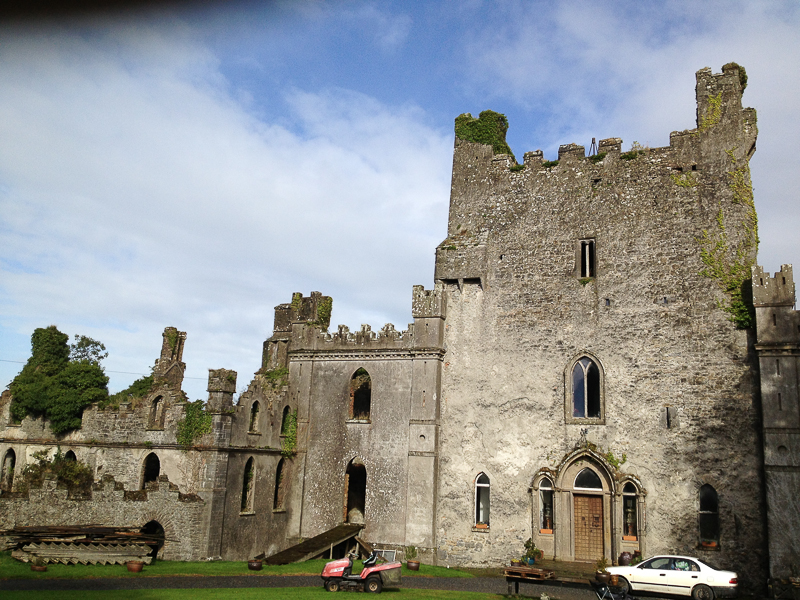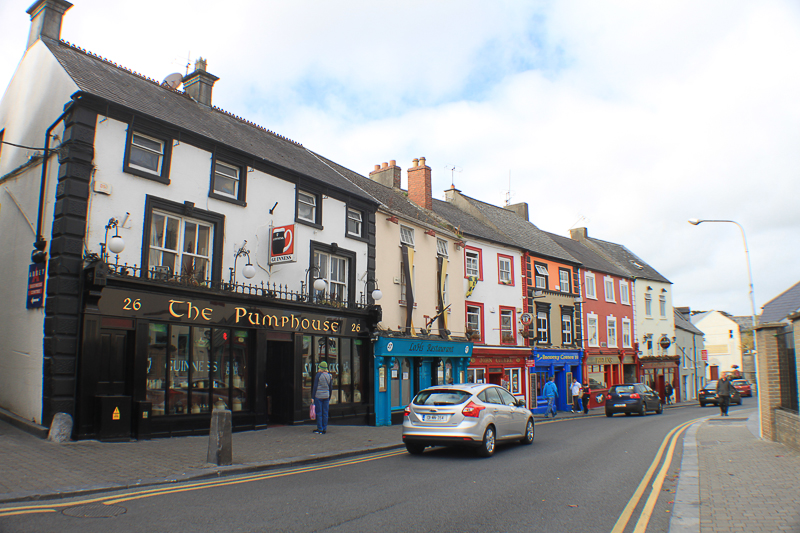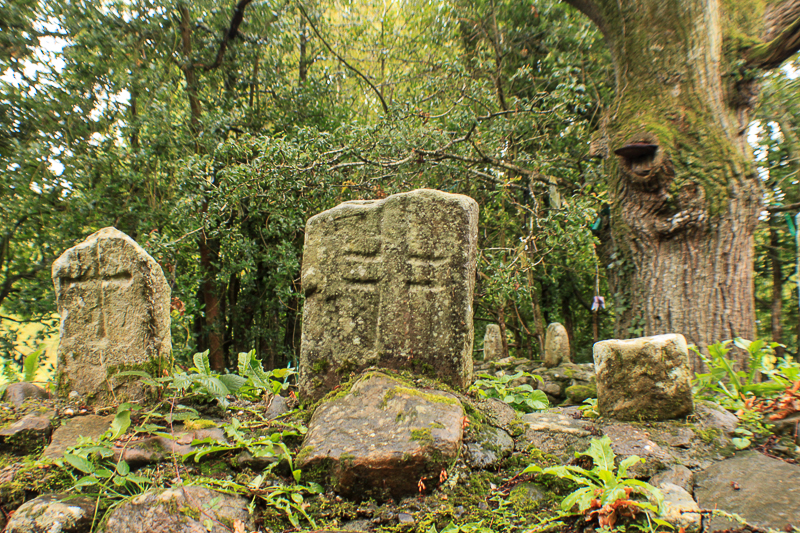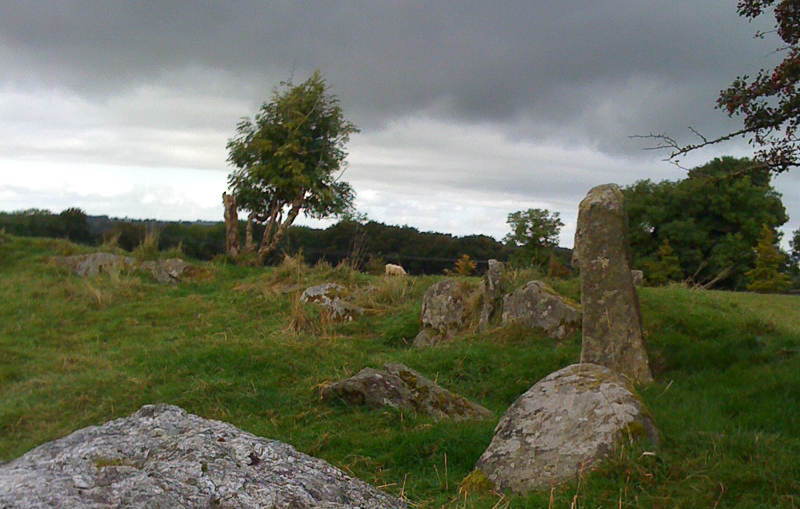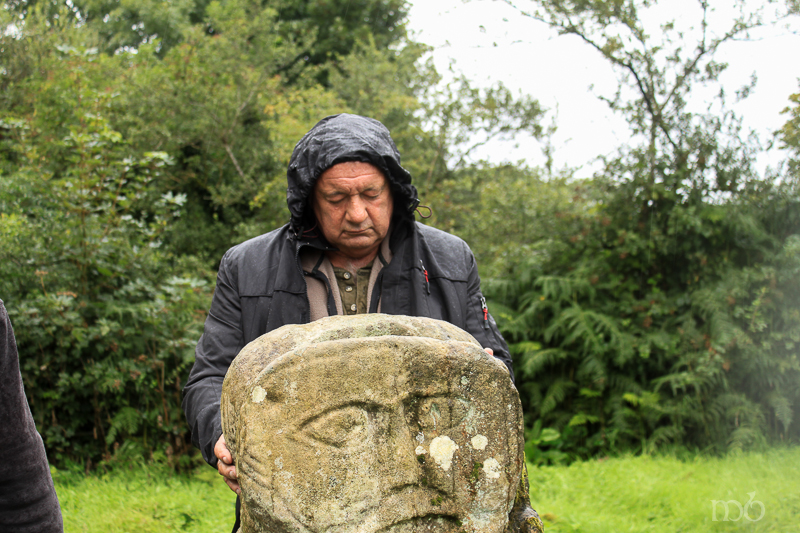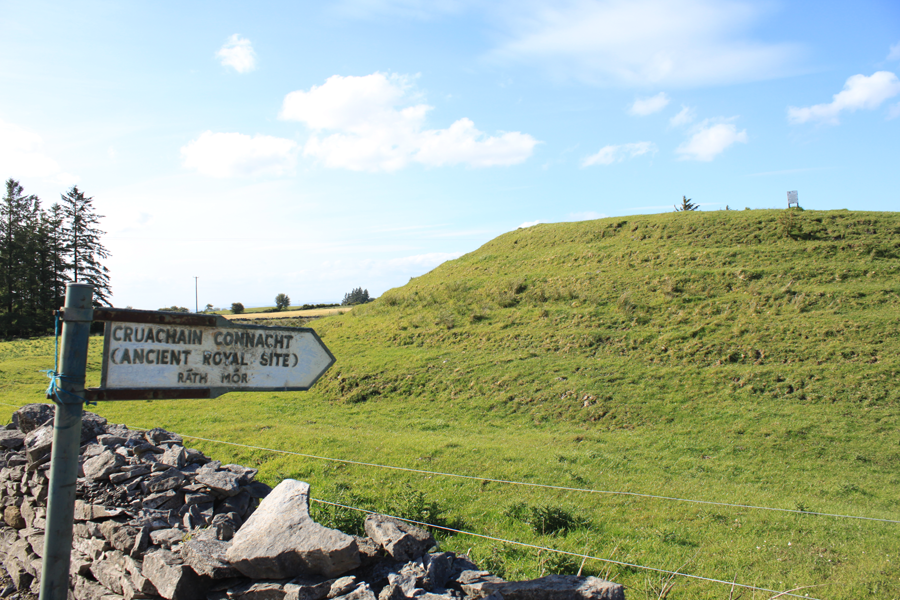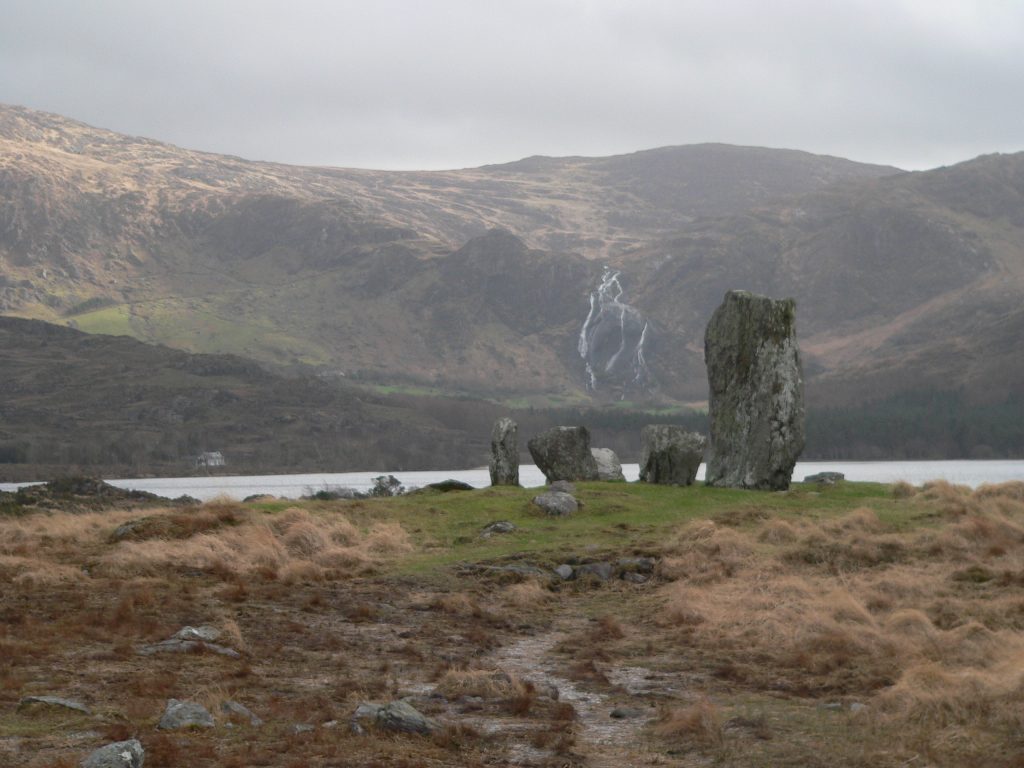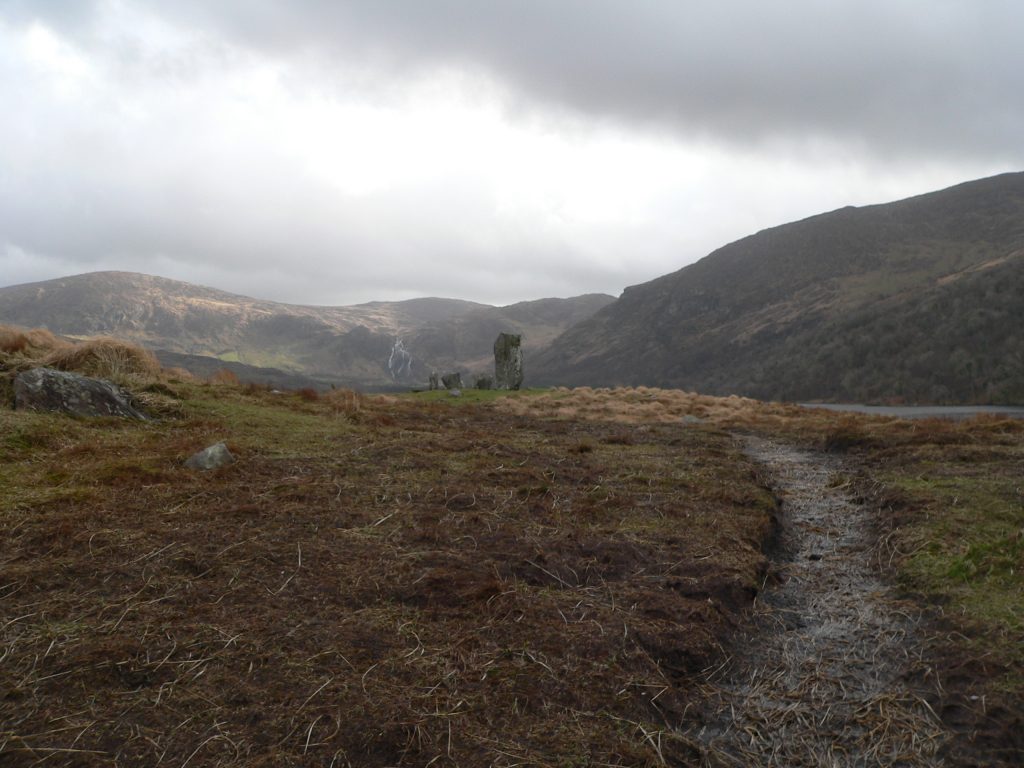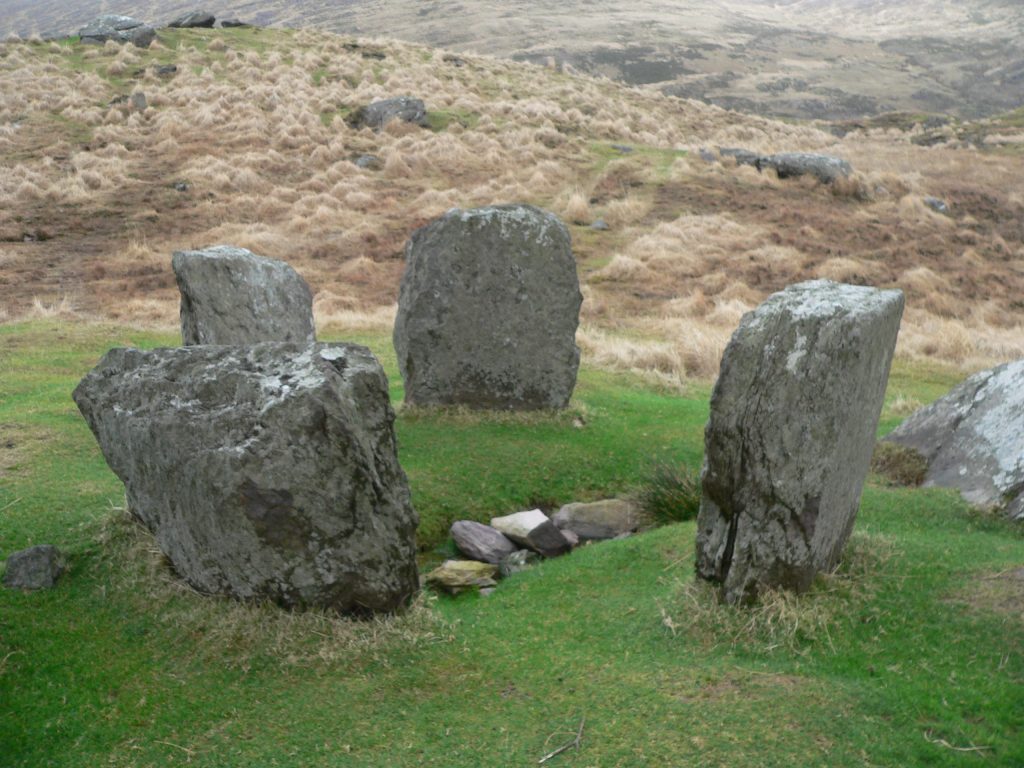Happy Candlemas – St Brigid’s Celebration
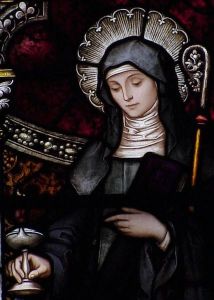
Happy Candlemas!
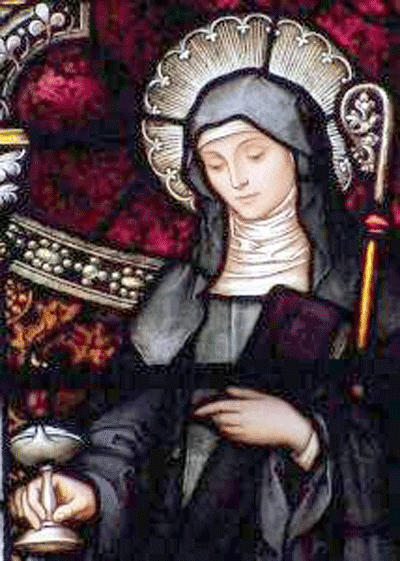
St. Brigid stained glass window
February 2nd – 02/02 – The feast of the flames – the bringing of the light.
This is also the Christian feast of the Presentation of the Lord Jesus in the Temple – the 40th day of the Christmas season.
So many cultures mark this day as a day to think of spring, of the thawing of the earth, the ending of the darkness, the long nights, the coming of the light. We think of St. Brigid of Kildare – Brigid the saint who brought the light of the Word, bread for the poor, peace to the troubled and welcome to the stranger whose feast day – February 1st is part of the “light” celebration.
Tree of the Day series
This is also the day I start a “Tree of the Day series” where I will post images of trees in thin places I have visit. These are special trees – fairy trees, healing trees, trees of mystery, trees associated with stories.
The Tobar Bhride Tree – Kildare
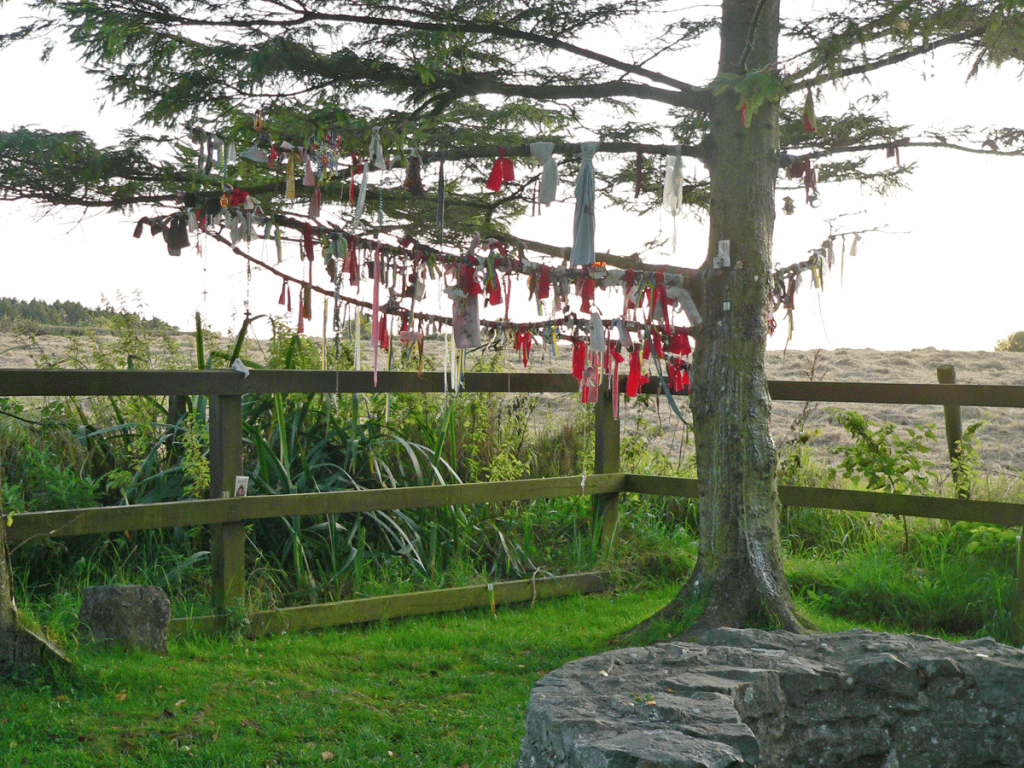
The tree at Tobar Bhride – Kildare
Today I’ll give you the tree at Tobar Bhride (Brigid’s Well) in Kildare. Local people and pilgrims from all over the world visit this well and the tree beside it bringing their prayers of devotion, special intentions and hearts full of thanksgiving for prayers answered.
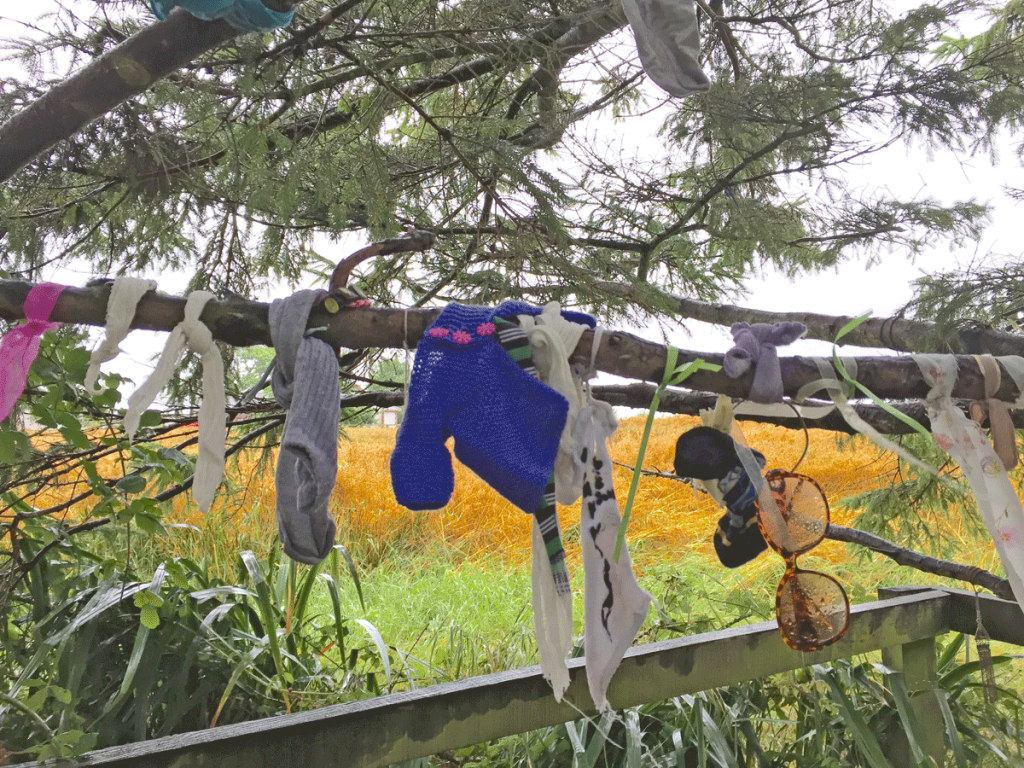
Tokens – “clooties” left on the branches.
As a sign of devotion, the faithful who visit the well sometimes leave a physical reminder of their prayer behind by tying a rag to the tree beside the well. Sometimes they leave something else of meaning behind – a possession of the person for whom they are praying, a photo, a prayer card. These tokens are called “clooties” and the lower branches of the Tobar Bhride tree is covered with them. Some of the clooties pull at the heart of the observer. .. pictures of sick mother, baby shoes, hair ties, little toys.
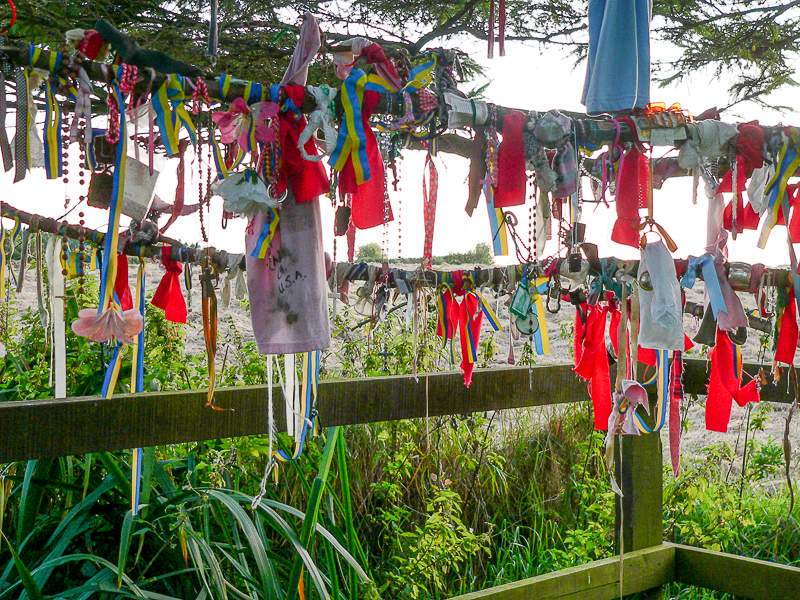
Clooties at Tobar Bhride Kildare
The local people who care for the well and its garden remove the clooties regularly to make way for more. According to the locals, the clooties are buried nearby. One cannot stand by the Tobar Bhride tree and not be moved. It has a quiet but powerful energy.
This tree, the holy well and the Solas Bhride center are a stop on the Discover the North, Castles & Saints and Trail of the Hag tours.
A Bridge to the Otherworld – A Rainbow at Beltany
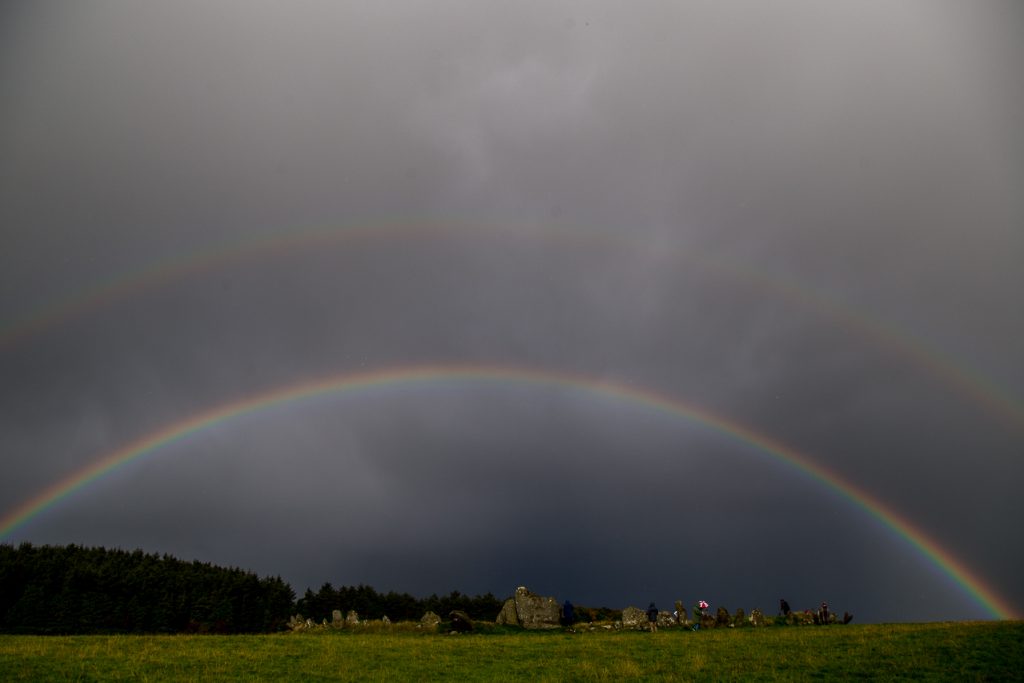
It appeared as if it was a bridge to the Otherworld… the rainbow we saw at Beltany stone circle on the eve of the Autumnal Equinox. The vision was certainly otherworldly. After seeing such a display there’s always the urge to make some kind of sense of it. To find some meaning.
Every culture has its own symbolic meaning for the rainbow. Most traditions focus on connection, a bridge to the otherworld, a promise from God, a sign of hope, a call to follow one’s heart. On the eve of the Autumn Equinox, I led a group up the path to Beltany stone circle in County Donegal. It was wet, rainy and overcast. The field approaching the circle was littered with cow dung. Several of my group turned back finding nothing particularly mystical about Beltany. But for those of us who stayed, the landscape shifted dramatically within fifteen short minutes.
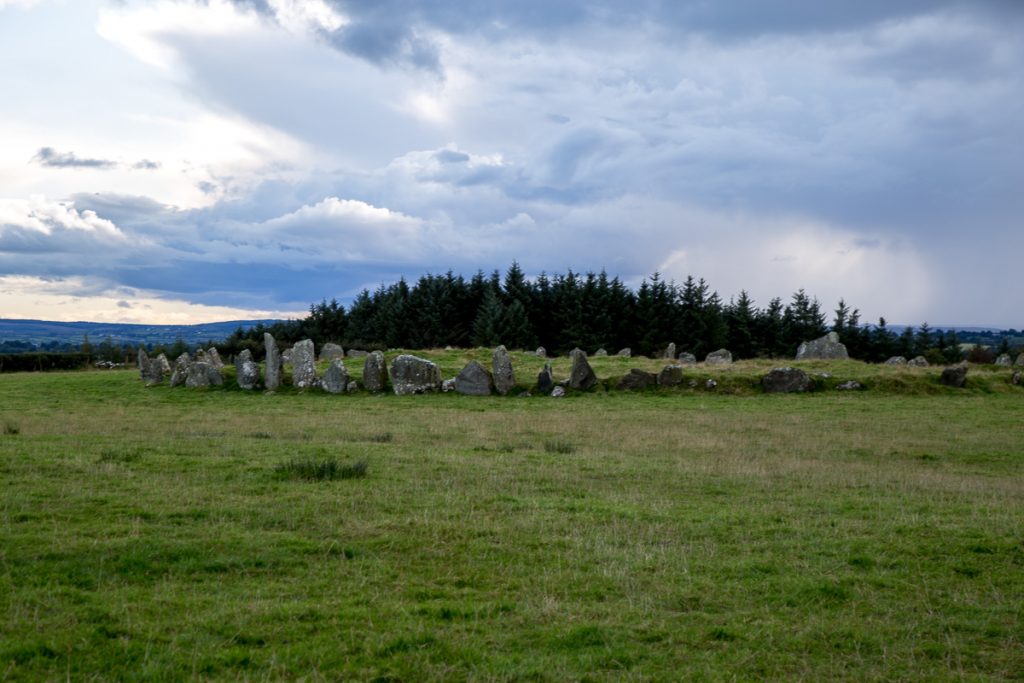
Beltany stone circle dates back to 1400 – 800 BC. With its 64 stones averaging 6 feet in height, it is larger than most found in Ireland. The circle measures about 145 feet in diameter. The site was significantly disrupted during an early twentieth-century excavation leaving the center of the circle lumpy with stones now covered by grass.
Most believe that there were at least 80 stones in the original circle. A wide triangular stone with cup markings immediately draws the eye and stands out from the others (shown to the right in the image above). It faces ENE and stands directly across the circle from the tallest stone (about six feet high) which points WSW. When the two stones align they point to the summit of a hill across the valley. On May 1st – the feast of Bealtaine – that the sun rises over that hill and aligns with these two stones. The circle’s name, “Beltany” likely refers to this celestial event and the feast of Bealtaine.
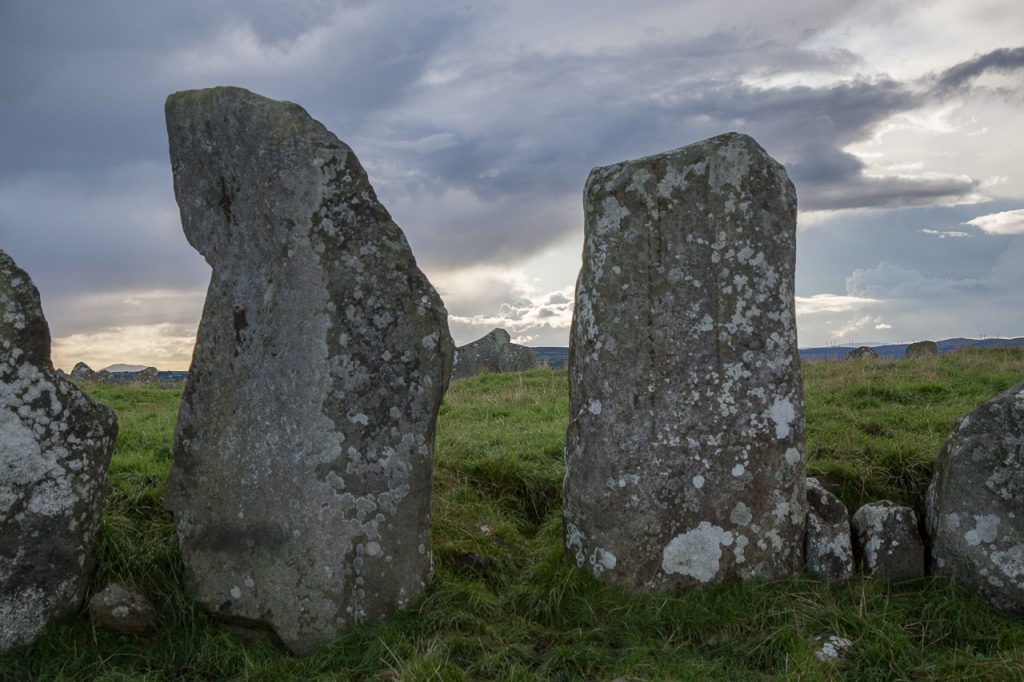
The Rainbow at Beltany
As we walked up the secluded path to the open field where the circle stands, my tour group was tired, the skies were gray and there was a slight drizzle. I was disappointed because I wanted my guest to love the circle as much as I did, but I could see that some of them remained on the bus and others exited quickly due to the difficulty of walking through a wet cattle field. I had only a portion of the tour group at the circle. Then it started to pour.
My heart sank. I want so much for this to be a perfect experience. But sometimes the weather won’t cooperate.
But sometimes the weather and the landscape surprises us.
As the rain softened, I happened to turn around toward the entrance to the field. I saw a pretty vibrant rainbow that was halfway across the sky. I called out to my tour guests to look at it. No one said a word – we just stared.
Then together we watched this rainbow spread perfectly across the sky over the circle. Then a second one appeared over the first. The clarity of the colors was stunning. Then we noticed that there was a darkness or shadow between the two bows. The space between was charcoal colored – different from the sky making the set of rainbows appear to be one thing.
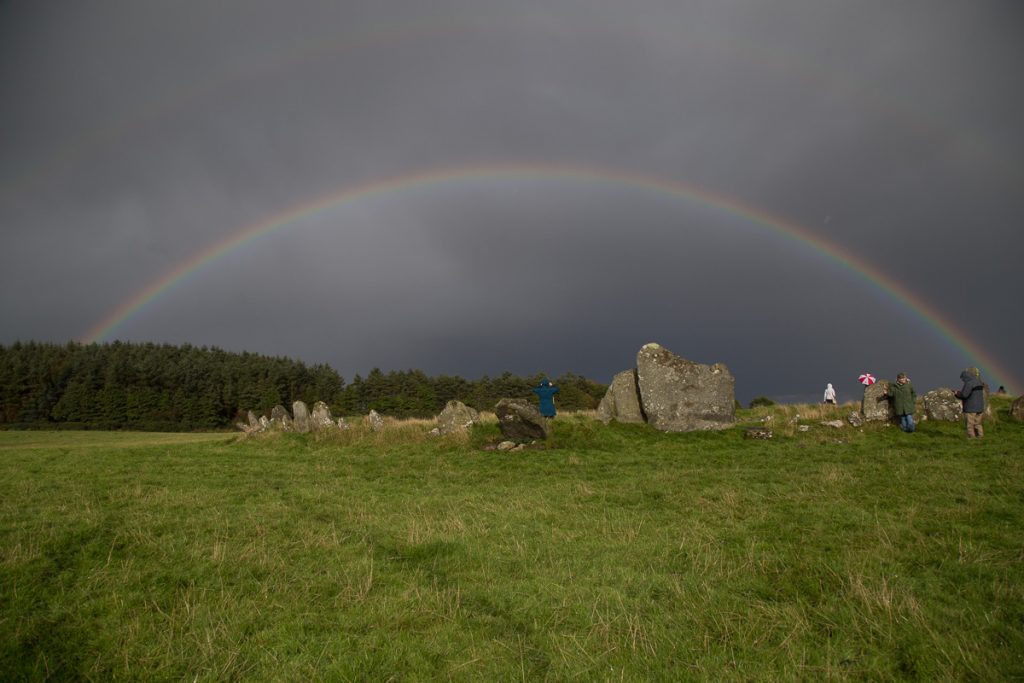
Even the sheep in the field were looking up at the rainbow.
One of my guests said, “In my seventy-one years of life, I have never seen anything like this.” It almost seemed as you could walk out to the end and touch the rainbow. Then the same guest pointed out that the colors were reversed on the second rainbow. Each rainbow was a reflection of the other with the colors going in opposite order – a perfect reflection – a mirror image. Traces of a third rainbow could be seen at the edges of the second.
The Symbolic Meanings of a Rainbow
A rainbow is a fusion of light that projects a harmonious – almost supernatural specter of all the world’s colors visible to the human eye. Every culture in every time has been moved by the sight of the rainbow. It nudges us to find some meaning in the presentation of something so spectacular. The Judeo Christian tradition is rooted in the book of Genesis.
It shall be, when I bring a cloud over the earth, that the rainbow shall be seen in the cloud; and I will remember My covenant which is between Me and you and every living creature of all flesh; the waters shall never again become a flood to destroy all flesh.Genesis 9:14-15
The first nations in North America, as well as many Asian cultures, saw the rainbow as a bridge or passage between the earthly and spirit worlds.
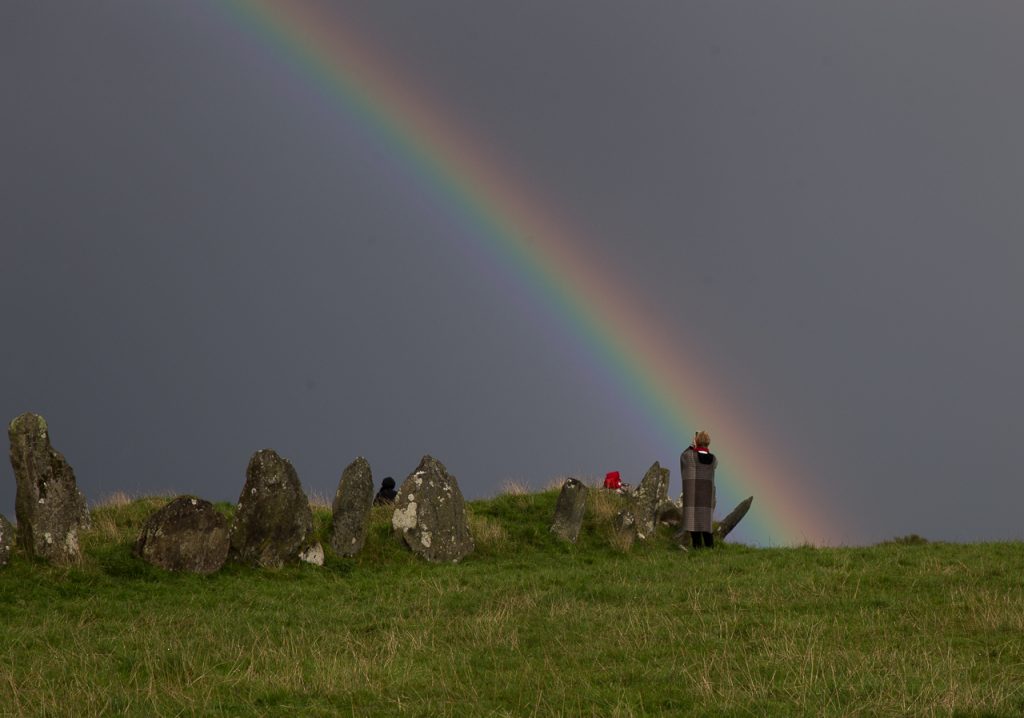
The ancient Irish or pre-Christian Irish saw the rainbow as a sign of blessing – the arc symbolized femininity – the rounded belly about to give birth, which is so appropriate for Beltany because the circle was likely created to celebrate that feast which encourages and blesses fertility and birth. The rainbow was often interpreted as a promise of good luck, abundance a sign to follow the heart’s desire or follow your dreams.
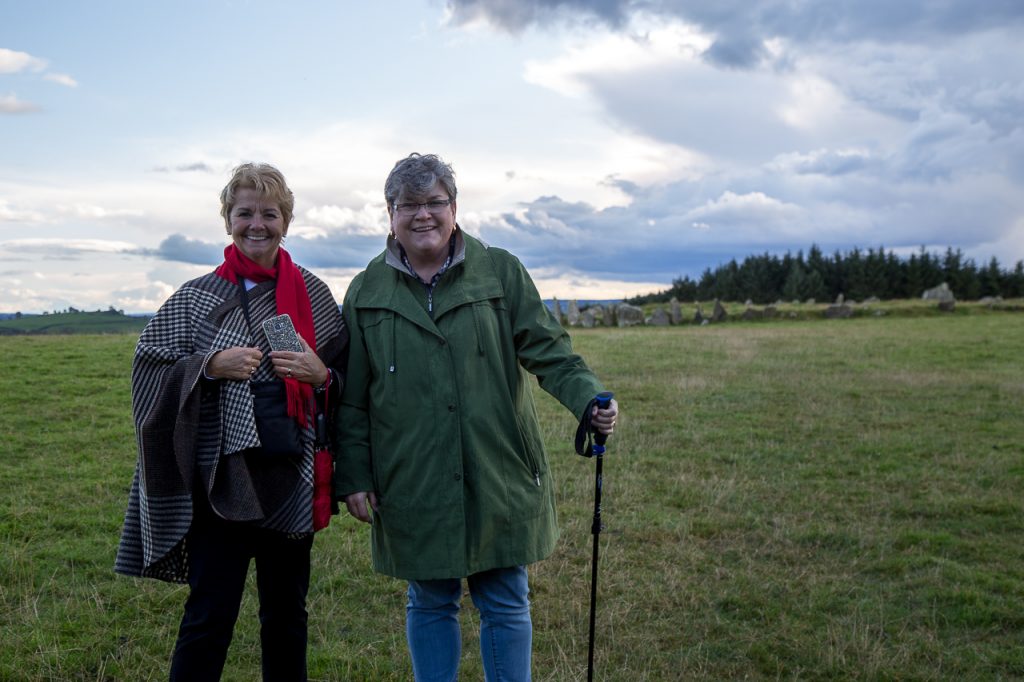
Guests on Discover the North tour after the rainbow
We’ve all heard of the old Irish saying to follow the rainbow and find the “pot of gold.” The rainbow was often interpreted as a promise of good luck, abundance a sign to follow the heart’s desire or follow your dreams. And standing at the edge of that circle and seeing the pulsing vibration of light against the field, one can perceive an actual “physical” end of the rainbow. Almost as if the pot of gold could be within reach. The light is mesmerizing.
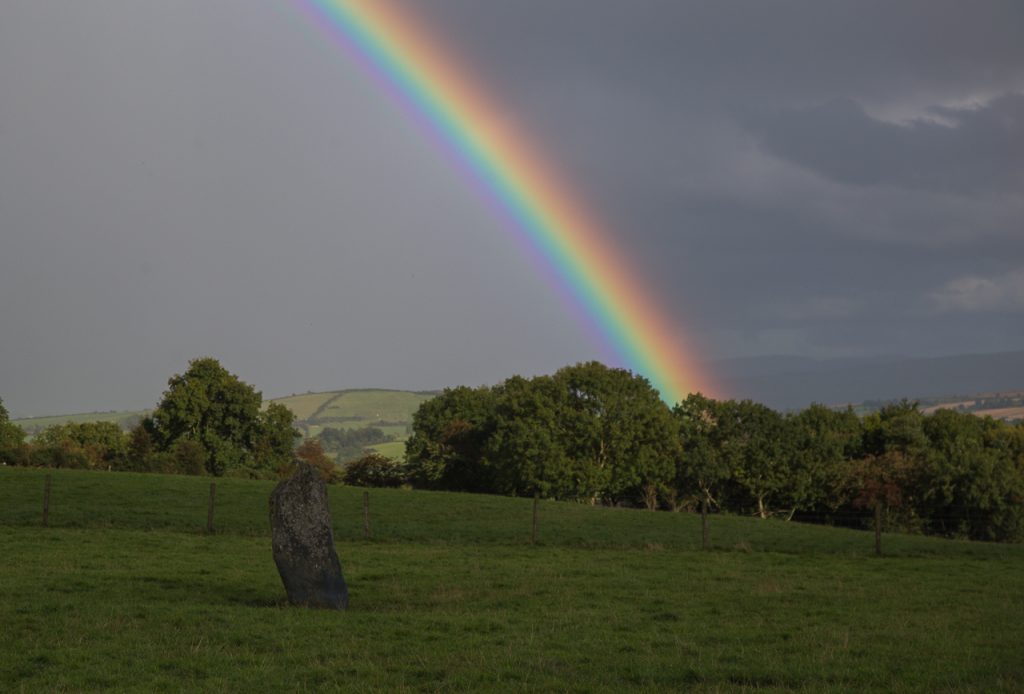
I love the kitschy words of the song from the musical Finian’s Rainbow
Look, look, look to the rainbow
Follow it over the hill and stream.
Look, look, look to the rainbow
Follow the fella’ who follows a dream
In the end, it doesn’t really matter what the rainbow means or doesn’t mean. Just standing in the presence of such a sight was gift enough for me. And it will always be a part of my memories of Beltany.
Fairy Tree at Grange Stone Circle
Fairy Tree at Grange Splits Stone
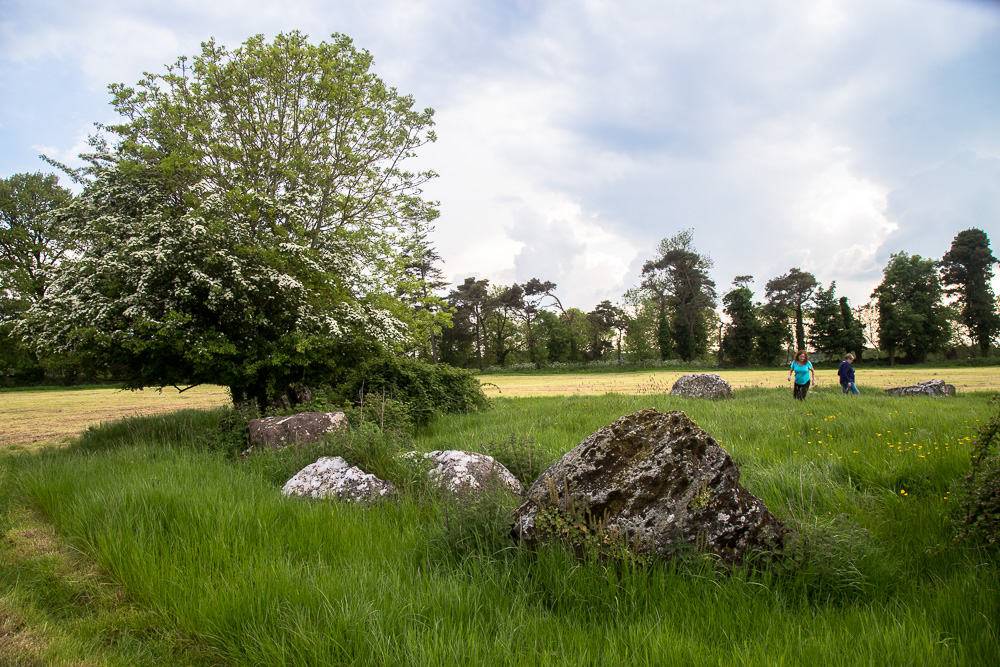
The fairy tree that split the rock at Grange Stone Circle II.
There is a fairy tree near the Grange Stone Circle has split on of the stone in two. The Grange stone circle in County Limerick is the largest in Ireland with 113 upright stones 150 feet in diameter. Many people don’t know that there is a smaller circle in the field next to the big one. And in that circle, the largest stone has a hawthorn tree growing out of it. The tree has split the stone in two and managed to thrive quite well.
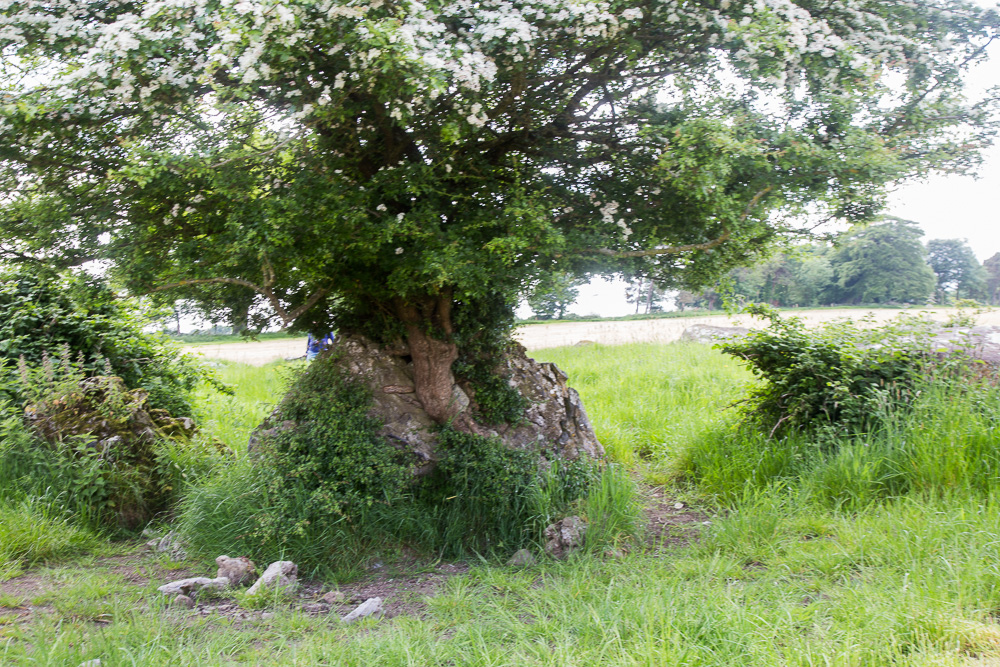
Further out in the same field is a tall standing stone and the farmer says that there’s another standing stone behind that one several hundred meters, though it is not visible to the naked eye.
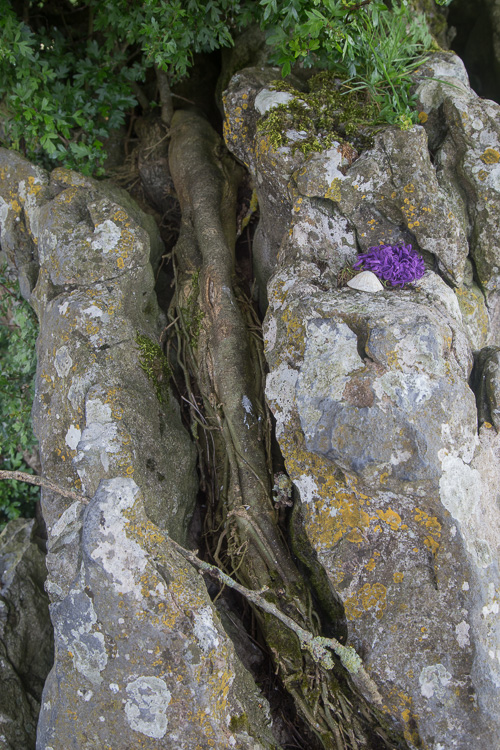
The tree growing out of the rock is said to be a fairy tree or a mystical tree associated with elemental beings (non-human spirits) of another realm or world…. kind of a parallel universe. There are many traditional folk tales about the fairies and how they don’t like being disturbed… and if disturbed will bring bad luck. Most Irish people will dismiss these tales as pure superstition, but at the same time, they won’t disturb them. There is a respect for the mystical.
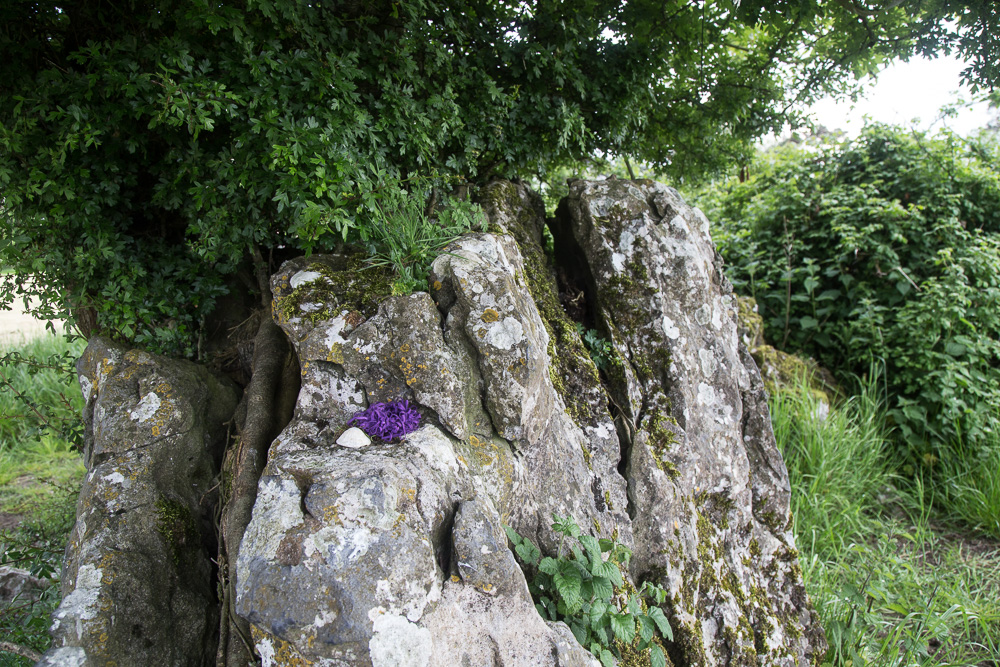
People still come to this tree and circle and leave tokens of devotion. You can see the purple ribbon and sea shell on the stone in the photo above. The entire region around the Grange and Lough Gur has an amazingly high energy vibration. I’ve taken groups there who have lost all sense of time in that place.
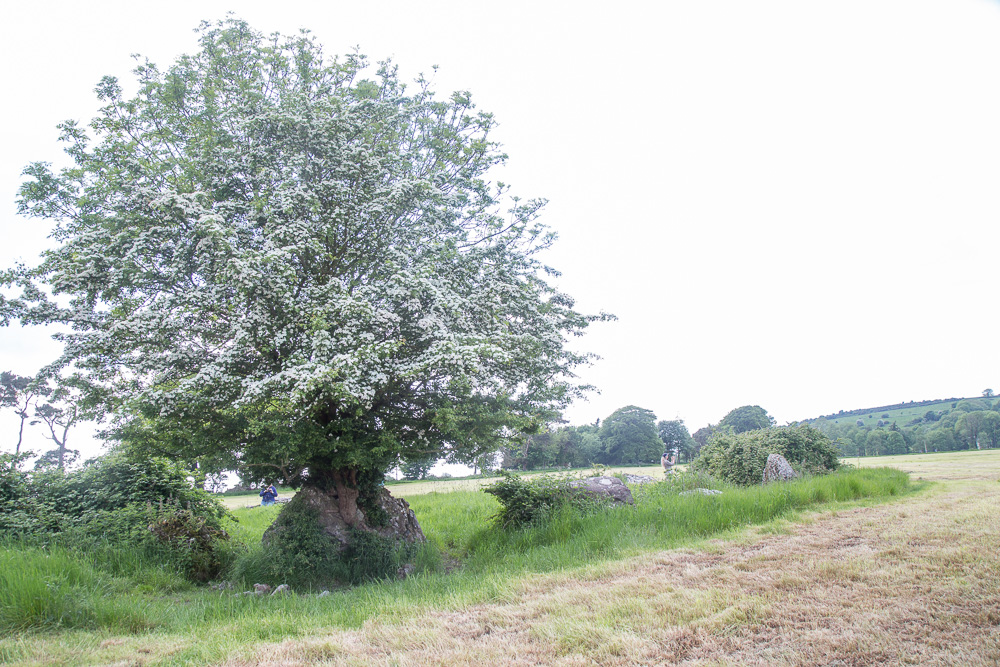
Fairy tree growing out of a rock – Grange Stone Circle II (smaller circle)
The Fairy Tree near the Grange Stone Circle and the surrounding sites are featured on the Places of Resurrection tour, Images in the Landscape Tour and Western Edges Tour.
Walking Meditation at the Hill of Uisneach
The Hill of Uisneach – a Thin Place

Guests at the Catstone on the Hill of Uisneach
The Hill of Uisneach is a thin place – one of those many luminal places in Ireland where the two worlds – physical and eternal – are fused together. It is an ideal site for being spiritually enriched by doing a walking meditation.
Few would realize as they drive along R 390 between Mullingar and Athlone, that they are passing through one of the most mystical places in all of Ireland – the mythological center of Ireland from where an ancient boulder marks the spot where all of the five provinces originate and come together… and beneath that boulder lies the goddess, Ériu, daughter of Ernmas of the Tuatha Dé Danann, earth mother of Ireland – and from whom Ireland takes its name – Eire or Erin.
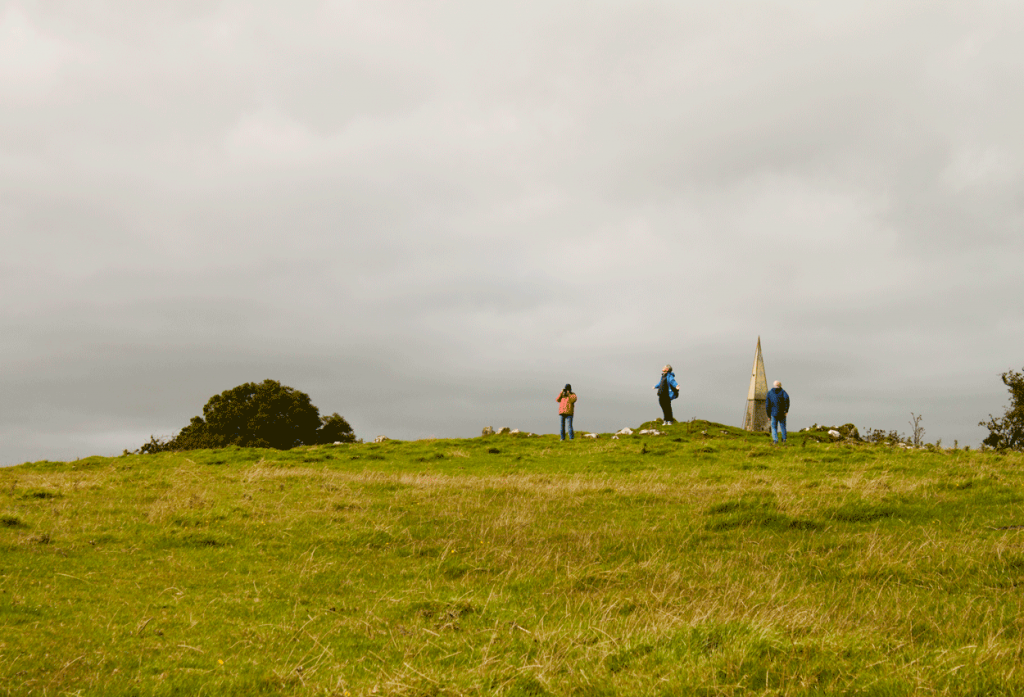
St. Patrick’s Bed on the Hill of Uisneach
From the pinnacle of the Hill of Uisneach, they say a person can see 20 counties. The Irish are always full of superlatives when they describe their archaeological treasures, but I will admit, the views are from that pinnacle – also known as St. Patrick’s Bed – are some of the most stunning I’ve seen in all my travels. The light seems to be different at Uisneach. The energy is riveting on this hill and its surrounds. And moving across this curvy greenscape of Uisneach dotted with stones, brush and lone hawthorn trees, one can see that it is a ripe setting for walking meditation.
Walking Meditation, the Process

Walking on the Hill of Uisneach
I learned about the process of Walking Mediation from my friend – and Brittany expert, Wendy Mewes. She does walking meditations with group tours that come to Brittany. The process that Wendy described is done completely in silence – even in a group. No one talks for the duration of the walk – perhaps 20 minutes.
As the walk begins, one focuses on the act of walking, moving through the landscape, being mindful of the body and the process of walking. Then one becomes mindful of the surrounding life force, noticing it in all living things around…sensing the force.. noticing that every living thing is charged with that divine presence, the presence of the creator – the great spirit – the source of all life and energy.
The third step of the walking meditation is to connect the two – your own life force with that of what surrounds you. What do the trees, the grass, the sky, the stones tell you? What do you hear from them? What do you learn from them? What are you sensing?
Sometimes, when the walking meditation is over, those on the walk discuss the experience and share what they learned, felt, were moved by, etc.
One can become totally consumed in mediation on Uisneach. The energy is overwhelming, and one can lose a sense of time and placement in the physical world. It’s no wonder that the ancients chose this spot for communal, spiritual practices. The Hill and its stories are tied to a tradition of spiritual power, rituals, traditions and mystical occurrences. It is one of Ireland’s most sacred sites.
Uisneach – site of the Bealtaine Fires

The Pinnacle – St. Patrick’s Bed – the Hill of Uisneach – The Bealtaine fires were lit near this site
Uisneach is said to be the spiritual and mythological center of Ireland – the Axis Mundi – Ireland’s naval – the joining point where all of the provinces come together in the center of the country, as well as the joining point between two worlds – the mystical and the physical. Archeological excavations show that Uisneach was likely a fire ritual site – a large one – a place where many people came together and celebrated the feast of Bealtaine.
The Catstone and Enchanted Lake

At the Catstone on the Hill of Uisneach
On the slope of the hill is Uisneach’s most famous landmark. The Aill na Mireann – meaning the stone of divisions, also known as the Catstone (so named because it resembles a crouching cat). This 30-ton limestone boulder that stands 16 feet high sits solitary on the lonely hillside. It was believed to not only mark the intersection of all five of Ireland’s provinces, it’s also said to mark the grave of Ériu, the mother goddess of Ireland, the one whom Ireland – Eire – is named for.
Uisneach was also said to be the site of one of the five great trees of Ireland – The Uisneach Ash – planted by Fintan the Seer who is said to have divided Ireland into its provinces with the stone at the dividing point – calling for there to be knowledge in the west, battle in the north, prosperity in the east and music in the south with royalty in the center. The Stone of Divisions. Since the stone touches every province, it also shares each province’s virtues. Thus we have the concept of all provinces meeting at Uisneach, and it being the mystical and mythological center of Ireland.
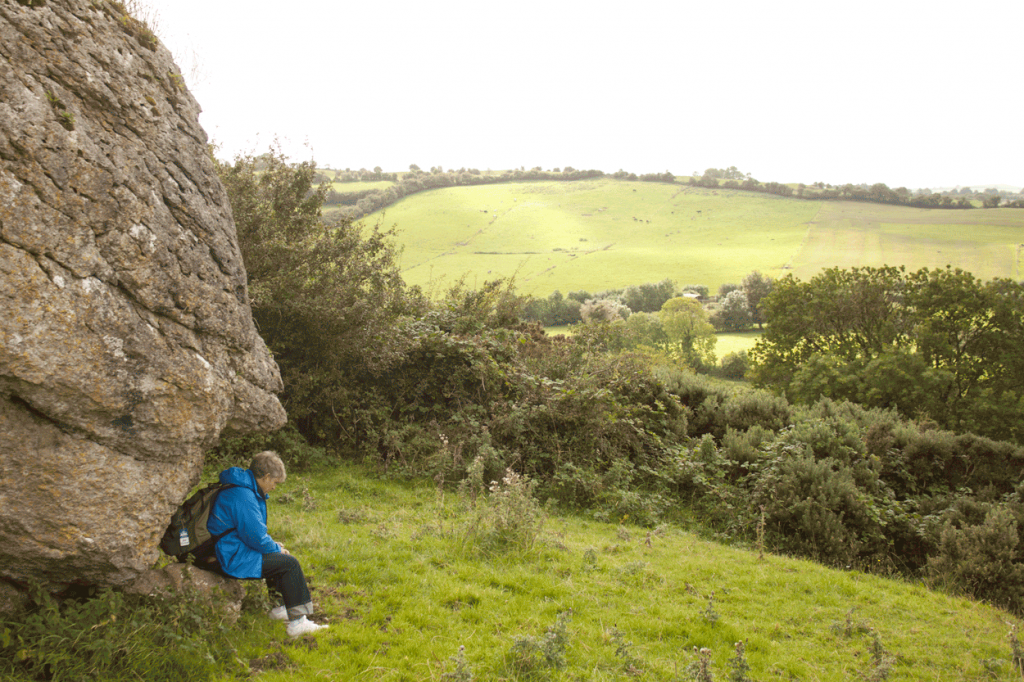
Sitting on the Catstone at the Hill of Uisneach
There have been people tracking ley lines throughout Ireland who see a common pattern with many lines leading to Uisneach. High Kings were once crowned at Uisneach before the Hill of Tara became the royal center for the country. So the legendary mystical character of the site goes back thousands of years.
There is a small (some believe enchanted) lake on the hill dedicated to Lugh, a member of the Tuatha Dé Dannan also known as the sun or harvest god. Legend states that Lugh battled with his brother on this hill and was drowned in the lake and buried under a nearby mound. Some believe the lake is enchanted.

Lugh’s Lake on the Hill of Uisneach
Not too far from Lugh’s Lake is the foundation of the old palace that sat atop the hill. Located in one on those grounds is another stone – nicknamed “the money stone.” It’s short and appears to have petrified wood drilled into it. The stone has amazing energy, and if you place your hand a few inches away from it, you can sometimes feel the energy coming off of it in the form of heat or a vibration. Using dowsing rods on the hill, we found the magnetic pull coming – not from the Catstone, but from the money stone. I’ve not been able to trace the origin of the name of that stone but can encourage people to seek it out.

Under the Fairy Tree – Hill of Uisneach – Images in the Landscape Tour 2015
Considering the ancient fire rituals, royal traditions, legends of the goddess, the Capstone, Money stone and enchanted lake, Uisneach is truly a mythological mecca for those who seek out thin places. A walking meditation here, is powerful food for the spirit.
White Park Bay on the Antrim Coast – Where the Sand Sings
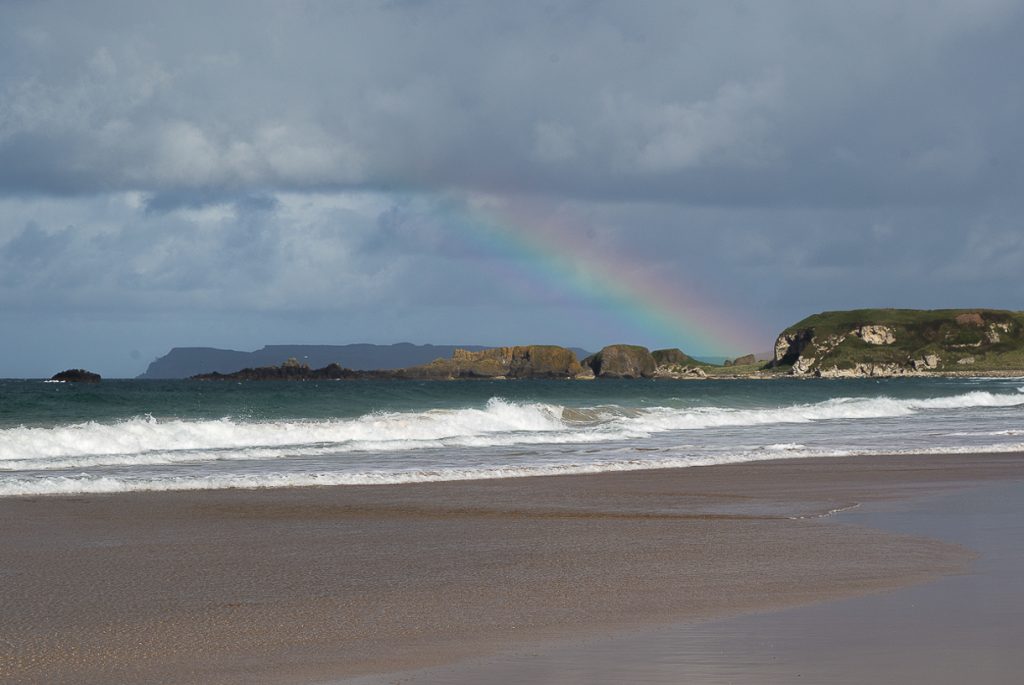
Whitepark Bay – County Antrim.
White Park Bay sits on the Antrim Coast between Ballintoy and the Giant’s Causeway. It’s a two-mile long, crescent shaped beach with a series of dunes that run up to a chalk cliff border. The landscape is an ancient one, and many believe that it was here that the first settlers entered Ireland. Artifacts found in the region date back to 8000, B.C.
Archaeologists believe that White Park Bay was a manufacturing hub for axes and arrow heads due to the availability of flint nodules in the cliff-face. The dunes just below the cliffs have been declared an Area of Scientific Interest due to the abundance of the fossils found in them and around them. The dunes are brush covered but in the brush are rare plants, grasses and a variety of orchids.
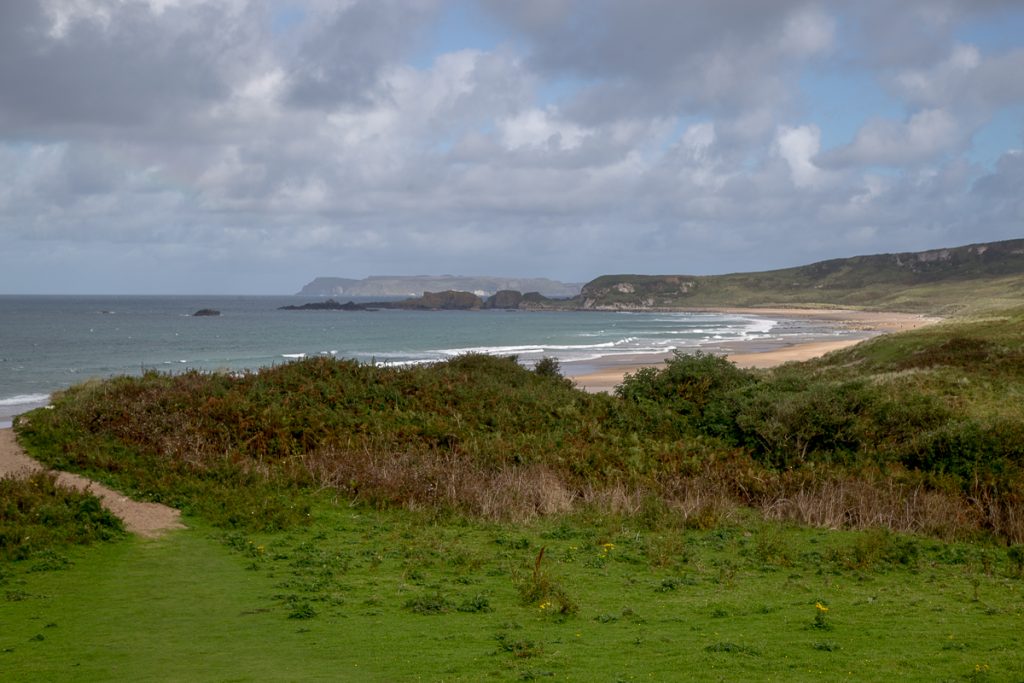
Whitepark Bay beach
The views are stunning, and if you’re lucky enough to get there on a clear day, it’s possible to see the coast of Scotland across the Irish Sea.
An Ancient Sacred Landscape
Buried under the brush in the cliff-face is an old passage tomb probably dating back to 3000 B.C. If you walk to the center of the crescent and stand with your back to the water’s edge looking back to the cliffs, you can there are 3 more passage tombs in the landscape. They are on higher ground across the road rising above the chalk cliffs. All these tombs face the sea. It makes one wonder if this area isn’t part of larger sacred landscape.
Sacred landscapes are charged with earth energies. White Park Bay has a rare energy and elements of enchantment. A man-made stairway makes getting down the cliff-face from the car park easy. The stairs empty onto a path that winds past the ruins of an old school and out to the wide beach.
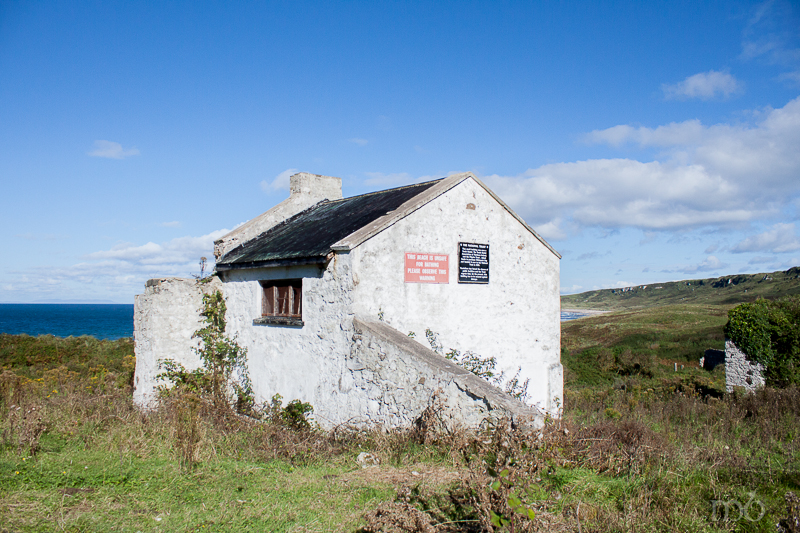
Old School – Whitepark Bay
The Singing Sand
Footsteps on the sand create a kind of “singing” or humming sound. This singing sand phenomenon that occurs on some beaches in the UK and in only 30 places around the world. Sometimes it’s a squashing sound that is made as a result of feet hitting the sand as a person walks across. More pronounced “singing” occurs as a vibration – a sort of humming that washes across the entire landscape.
The day I visited White Park Bay, I specifically listened for the singing and didn’t hear it. Finally I picked up on the squashing sound when I walked across the sand, but that was near the dunes where the sand was more loose and dry. But when we came out into the open – out in front of the dunes, I heard it faintly at first … the buzzing sound … a hum. Then it faded. But it was a remarkable thing to hear.
This video on www.BoreMe.com demonstrates both kinds of singing sand and offers some explanations about why this phenomenon occurs.
Faces in the Stones
The stones on the beach at White Park Bay are either smooth like river rock or sharply cut like fossils. The stone colors are mostly white accented by shades of grey, but they’re incredibly bright. I’ve seen faces and shapes in random stones before, but it’s usually one or two after I’ve combed through stones for about an hour. And White Park Bay they seemed to pop out of the landscape everywhere. I found myself seeing faces on every other stone. This is a psychological phenomenon – seeing faces or shapes in meaningless randomness. Carl Sagan suggested that humans are hard-wired to look for the human face. Psychics and Spiritualists will say this is part of being Clairvoyant – that the shapes or face images are derived from both the brain and a universal source.
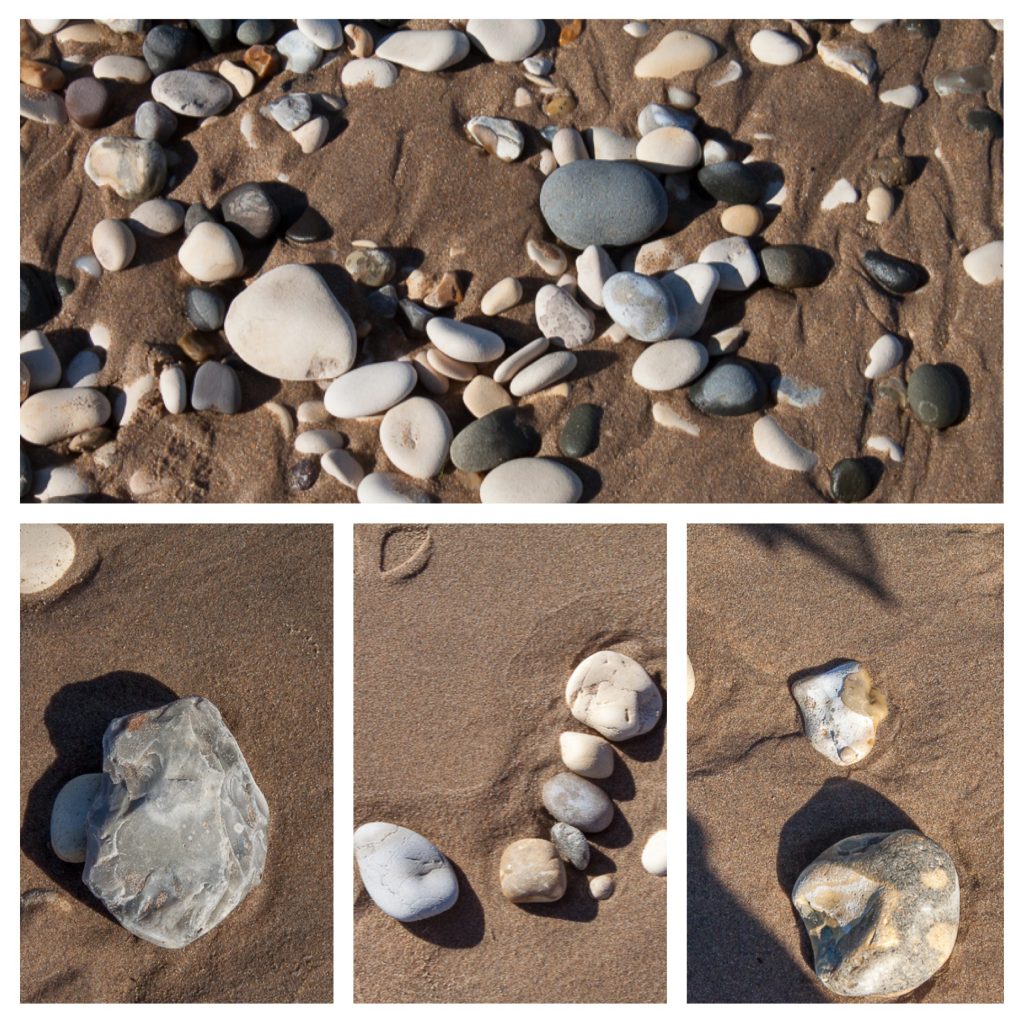
Whatever it is – a psychological phenomenon or a psychic capability, it seems to happen in exponential proportions at White Park Bay.
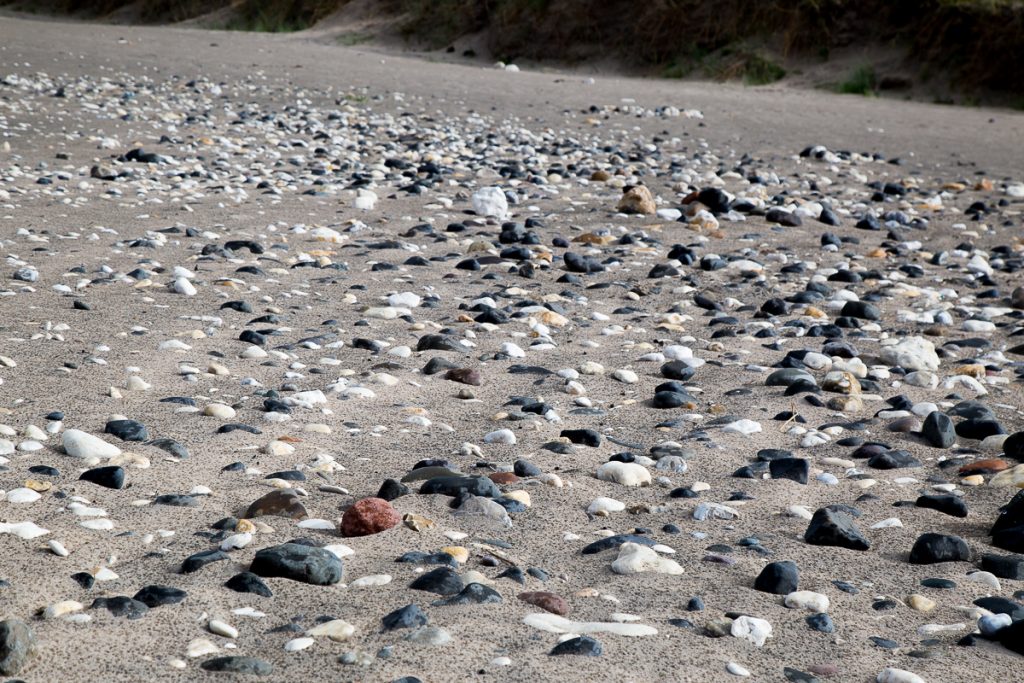
I visited White Park Bay with my friend Maura Brooks who lives in County Tyrone. I was telling Maura about a tradition I started with my twin granddaughters since I travel so much. I always bring each of them a heart-shaped stones from wherever I’ve gone. The easiest place to find them is on a beach where there is an abundance of stone.
I’m usually pretty lucky and after about a half hour to an hour I’ll be able to find two that resemble a heart shape. If I’m with my husband, he’ll help and we both look. So I asked Maura to help me look at White Park. Within minutes after beginning the search I found a perfectly shaped heart stone. Then another. Then a third. It was crazy. The hearts were all but jumping out of the sand. Maura found several as well. Within about 10 minutes we found eight heart-shaped stones and two feathers.
In the Celtic tradition, feathers a symbolic of knowledge from the celestial realm. Egyptians, Europeans, the Nordic people and First Nation people in the Americas all shared a similar interpretation of feather symbolism and used feathers as ornaments in ritual dress and practice. Basically, feathers symbolize the connection between the heavenly world and the physical world.
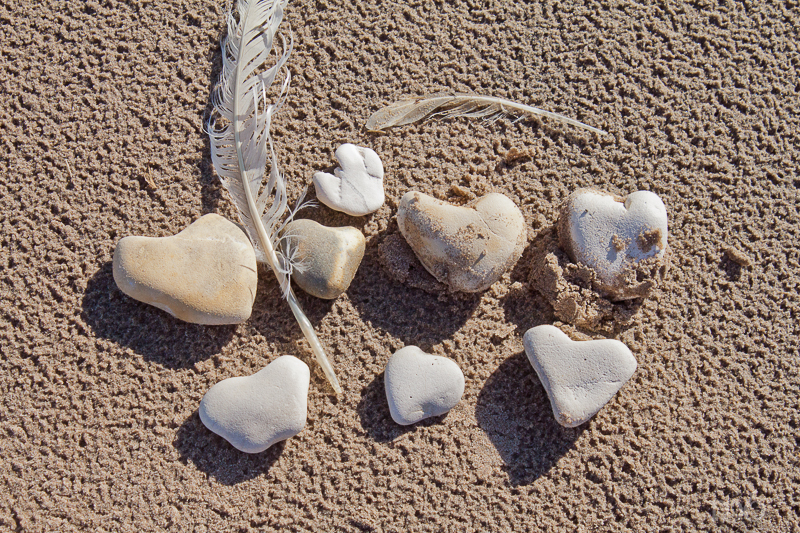
Hearts at White Park Bay
First the singing sand, then the stones with faces, and now the hearts finding us. This was a magical place.
Touching the Other Side at White Park Bay
My friend Maura is a psychic and a medium. When we first walked out onto the beach there was a large stone with a child’s shoe on it. I assumed someone found it and set it on the stone in case a parent came back looking for a lost shoe.
When we left White Park Bay and climbed the stairs that led back to the car park, we noticed a bench that visitors could sit on and look out across the beach and sea. It was almost at the very top of the cliff. The panoramic views from there were awesome. It was an amazingly peaceful setting.
I sat down on the bench, then we both noticed that just in front of the bench were wilted a cluster of wilted lilies.
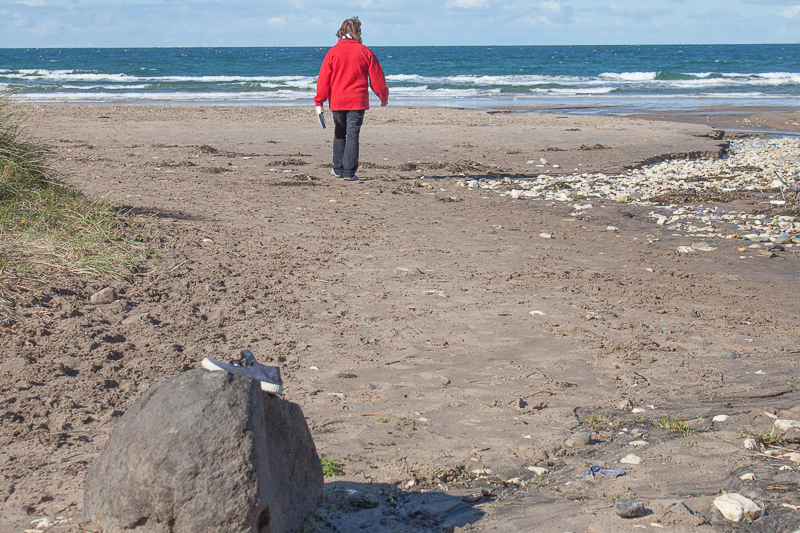
Then Maura heard the words “Good-bye, little one.” She sensed that the shoe belonged to a child who died and the parents placed the shoe on the stone and then released the child’s ashes over the cliff in front of this bench – and then left the lilies as a symbol of remembrance.
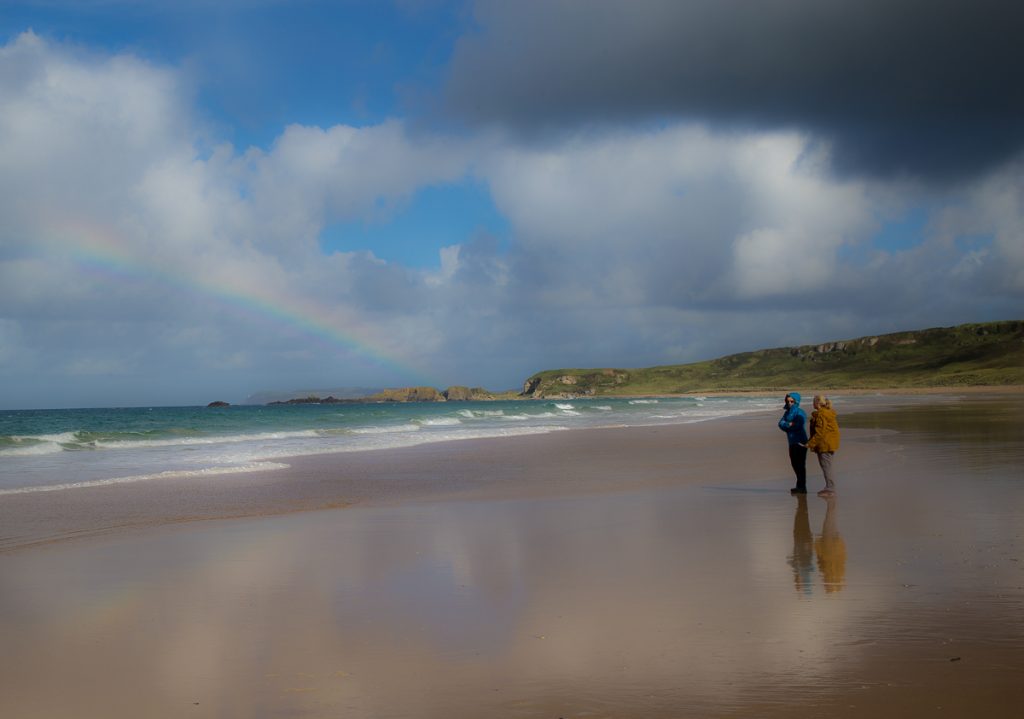
Walking the beach in September – White Park Bay
White Park Bay is a secluded beach in a pristine setting that is worth seeing if just for the stunning beauty of the Antrim Coast. But if your senses are keen and you open yourself to the eternal world, White Park Bay is one of those rare, thin places where it’s possible to walk in both worlds simultaneously.
White Park Bay is on the Discover the North Ireland Tour .
12 Pictures that Will Make You Want to Tour Ireland
Ireland and its thin places have such a draw for those interested in traveling a bit deeper into the landscape. Here are 12 pictures that show some of these amazing places. All of them are on our Castles, Saints & Druids Thin Places tour this September 2014. Join us!
1. The King Oak
The King Oak is said to be between 500-800 years old. It’s part of an ancient oak forest once sacred to the Druids, then later the site of a monastic community. The forest entombs Charleville Castle, a gothic-style castle built from 1798-1812. The King Oak ranked #3 in Europe’s Tree of the Year 2013 and it’s a familiar old spot to the people around Tullamore. Many a romance started and ended beneath the branches of this tree. The spread of the lower branches spread out over 150 feet from end to end. This oak is set in an ancient grove with other trees that are hundreds of years old. When the British invaded Ireland and occupied the country, they ravaged the land, stripping it of all its forests, then exported the wood for profit. Fortunately this oak forest was part of a 1700 acre “gift” from Queen Elizabeth I to the Moore family. The gentry tended to keep the trees on land around their homes. This oak forest has been considered magical for centuries.
2. Charleville Castle
Charleville Castle was built by the Earl of Charleville between 1798 and 1812 in an ancient oak forest near Tullamore. The site was formerly occupied by the Lynally monastic community, and before that was used by the druids for sacred rituals and ceremonies. It is currently owned by a non-profit that uses volunteers from all over the world to help restore the castle and bring it into a self-sustaining existence. The caretaker says that the designers of the castle were Masons and positioned the round towers on crossed ley lines which creates a powerful energy field in the tower rooms. The caretaker also has experienced ghostly sitings that include druids, the Earls of Charleville and the castle designer. Many believe that a little girl named Harriet who was the daughter of the third Earl of Charleville haunts the back staircase where she fell to her death after trying to slide down the bannister. Charleville Castle and its surrounding oak forest is considered one of the scariest places in Ireland.
3. Castleruddery Druid Stone Circle
Castleruddery Stone Circle in County Wicklow is a Bronze Age Druidical circle once used for ritual. There are a total of about 40 stones on the site but the circle itself has about 20 standing stones places on a raised embankment. This would have been a place of great importance based on the geographic layout of the stones, embankment and ditch that is dug outside the embankment. Two large quartz stones mark the portal (entrance) of this circle. Quartz in an amplifier of energy and believed to have healing properties. Some locals from this area believe this stone circle has healing properties. There is also a fairy tree in the circle (pictured here). The roots are wound around a standing stone. Some of the stones have cup marks carved into them and notches carved across.
4. Glendalough
Set in the Wicklow Mountains, Glendalough (meaning valley between two lakes) features the ruins a Medieval monastic city founded by St. Kevin in the 6th century. In the last two centuries it’s been used as a graveyard for local families, but the old bones of the monastic city can still be seen in the hilly landscape. ruins of churches, round-towers, buildings dating from the 9th to 13th century make this site absolutely enchanting. The views of the glen and lakes and babbling stream connecting the lakes are also remarkable. Our Castles, Saints and Druids tour group will be overnighting in the Glendalough Hotel in September.
5. St. Kevin’s Kitchen – Glendalough
St. Kevin’s Kitchen is a 12th century church in Glendalough, and often used as a defining landmark for the ancient monastic city. The church has a stone roof with a round tower built into the roof. Round towers were used for bells, for look-out stations to see people approaching from a distance.
6. St. Berrihert’s Kyle – Glen of Aherlow
St. Berrihert’s Kyle is a round structure built by the local people from pieces of an old monastic ruin. It was made to mark a Cillini or burial ground for unbaptized babies and others not qualified for sanctified ground. The kyle is a complete circle set in an oak grove in the Glen of Aherlow in County Tipperary. Pilgrims travel from all over to pray here. They leave behind devotional tokens – some very rare. These tokens are offerings left in hopes that their prayers will be answered. There is also a holy well (more like a small pond) nearby that is flanked fairy trees covered in clooties, also left by pilgrims.
7. The Rock of Cashel
If the Rock of Cashel doesn’t inspire you, nothing will. This cluster of ruins atop a rocky hill in County Tipperary can be seen for miles. It always reminds me of Emerald City in the Wizard of Oz. The Rock is set in the middle of agricultural land known as the “Golden Veil” because of the bounty of food it produces, and that land is ringed by mountains. The views from the Rock are stunning, and the energy and power of the site radiates in almost fearsome abundance. This is a must-see site in Ireland.
8. The Hill of Tara
This is the Lia Fáil or Stone of Destiny perched atop the Hill of Tara – a corronation site once used for crowning the High Kings of Ireland. An old legend states that if the true High King was crowned, the Lia Fáil would literally cry out or roar. If this stone looks phallic to you, that’s because it’s meant to look that way. The ancient pagans didn’t have the sexual hang-ups of our present world. They believed that male and female were two aspects of the Divine. In this case the stone may represent the male Divine aspect in union with the female aspect (the earth). The stone is believed to have magical properties – those properties were demonstrated the roar of the stone during coronations. The Hill of Tara has a brilliant earth energy.
9. Newgrange Passage Tomb
Newgrange, the Boyne Valley is Ireland’s oldest building remaining fully intact. The tomb dates back 5000 years, predating the pyramids of Egypt, Stonehenge and all the other tombs and prehistoric enclosed structures in Ireland and Britain. Newgrange was a center for spiritual ritual and has remained intact since the Stone Age. The inside is large with a center chamber large enough for 20 people to stand and three side chambers. The entrance is shown in this image (center). Above the opening the tomb is a stone lintel which allows the passage of light to penetrate the pitch blackness of the tomb during the sunrise on the Winter Solstice (December 21) – the shortest day of the year. Visitors to Newgrange can walk deep into the passage tomb and a guide uses an electric light-beam to demonstrate the shift from dark to light during the Solstice sunrise.
10. Sheela-na-Gig – Kildare
There are people who search for Sheela-na-gig’s all over Ireland and in other Celtic countries. These figures are usually primitive carvings in stone that depict a female revealing her genitals with legs spread wide open … usually with some kind of angry face. Some say the Sheelas were fertility goddesses, others believe they a defense against evil or bad energy similar to the function of a gargoyle. They are often found over doorways or beside entryways in churches and castles. Ireland has the most known Sheelas of any country (101). This Sheela-na-gig is hidden under the altar at St. Brigid’s Cathedral in Kildare. As our Thin Places tour group wandered through this beautiful and ancient cathedral, one of the cathedral staff people pointed this out to me. It was tough getting a picture (had to practically lay on the floor), but it was well worth it.
11. Leap Castle
Leap Castle is still being restored by its owner, musician Seán Ryan and his wife. The castle located in County Offaly was built by the O’Bannon clan in the 13th century, and later came under the ownership of the O’Carroll clan. It is said to have been built on a former ceremonial site used by the druids, and archaeologists estimate there has been human habitation on the site since the Iron Age (500 BC). Leap is famous for being haunted, probably because of the violence that has occurred there. The O’Carroll clan, warring over leadership resolved the conflict when one brother (a priest) was saying mass for his gathered family members in the chapel on the upper floor of the tower. Another brother burst through the door and murdered the priest with his sword in front of the family. Thereafter the upper floor of the tower was known as “the Bloody Chapel.” Leap also has an “elemental” or non-human spirit that has been seen as a shadowy figure that makes mischief.
12. Kilkenny – Downtown
While we all love thin places and mystical landscapes, no travel to Ireland is complete until the visitor gets to experience the Irish culture, and Kilkenny is certainly a vibrant town of culture. The name Kilkenny originates from the Irish words that mean Church of Canice and St. Canice’s Cathedral and round tower sitting atop a hill anchors one end of the city while Kilkenny Castle anchors the other. In between are shops, galleries, pubs and heritage sites. This was once a hub for monastic communities. The Grey Friars were here as were the Franciscans – St. Francis Abbey is now home Ireland’s oldest operating brewery which makes Smithwicks and Kilkenny beer. Walking the Kilkenny’s downtown is an excellent way to engage in conversation with the Irish, and the most memorable thing you’ll do on a trip to Ireland is engage with the Irish people.
All of the pictures above and the sites mentioned are part of our Castles, Saints and Druids tour for 2014. It runs from September 11 – 21st. It is a small, specialized tour focused on mystical sites ranging from the ancient druids to the monastic communities through the times of the British occupation. The cost is $2099 per person + airfare. For more details check out the Tour Itinerary.
6 Reasons to Tour Ireland’s Thin Places
On a thin places tour of Ireland, the traveler focuses on places where the veil between this world and the eternal world is thin. In these mystical places spiritual energy is high, and there is a strong sense of the life force that charges every living thing. Thin places have a special energy, a vibration that resonates. The landscape has a magnetic pull.
While thin places exist everywhere, Ireland has hundreds scattered over a country that is barely the size of West Virginia or Vermont. If you are intrigued by ancient standing stones, old oak trees, monastic ruins; if you’re inspired by castles, intrigued by stories of heroes, giants, goddesses and kings; if you hunger for a connection with your ancestors or long to go deeper into your own spirit and soul, then you’re ripe for a mystical tour of Ireland’s thin places.
Here are six reasons to tour Ireland’s thin places:
1. You’re Searching … Spiritually
Perhaps you are longing to know more about what lies beyond earthly existence. Maybe you have a desire to travel inward, a desire to belong to something greater. You love nature and know that every living thing is charged with the Divine presence. You love history and stories of your ancient civilizations.
You want to connect with an ancient landscape – to touch the Other world – to draw from it, to feel the pulse of the earth’s energy, to feel the presence of those who went before and those who will come after, to walk in a magical landscape in order to discover your own inner landscape.
Next Thin Places Tour of Ireland is September 2014. Register Today.
2. You’re Growing … Spiritually
You already have one foot in this world and one in the Other world. You may have a great affinity for trees, for stones, for wildlife, mountains and the sea. Sometimes you journey during meditation. You believe there are no coincidences. To you coincidences and synchronicity are the language of the spirit world. Sometimes you can sense the memories of the past in a particular place. You are intrigued by old stones, by art, poetry and music. They transport you into a higher existence. Yet though you have these sensitivities, you know there is more. You’re looking to perfect your gifts and you’re hungry for a deeper understanding.
3. You’re Already Using Your Spiritual Gifts
Perhaps you’re a healer, a priest, a spiritual director, and energy worker, a psychic medium, a mystic, a therapist, or someone who offers powerful prayers for others. You’re able to walk in both worlds and have an internal sense of the Divine. You successfully communicate with spirits and otherworldly beings. You may have a strong understanding of earth energies, and can feel the vibrations in a highly charged site. You may have an understanding of the spiritual power in ritual and devotion (rounds of prayers such as the rosary, ritual practices, meditation, pilgrimage, visits to holy wells).
4. You Are a Teacher
You may be responsible for teaching others spiritual or healing practices… a practitioner who trains others, a mentor, an artist, a therapist. In a world where spiritual leaders are scarce and negative forces threaten to quench the zeal and passion of those who seek a higher existence, being in a mystical landscape refreshes and strengthens the soul. Creativity thrives. Needed spirit guides appear. Lifelong friends are made.
5. You’re in Need of Healing
Whether it’s physical, emotional or spiritual healing you need, Ireland’s thin places have a strong, healing energy. The soul soaks up this energy with every step into the mystical landscape.
6. You Love Someone Who Fits the Descriptions Above
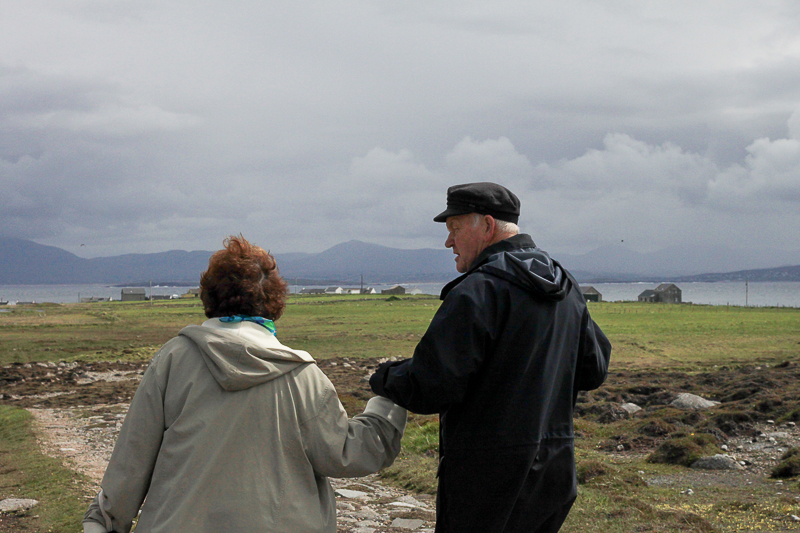 People on spiritual journeys often reach out for the support of friends or family. While some like a solitary experience, others want a close companion or soul mate to travel with them. Though you may not be searching spiritually, or looking to deepen your own understanding, you may be called to support someone who is. Often times people who support others on a thin places journey will find unexpected benefits in their own lives. It may be nothing more than relaxation and a calming of the spirit, but if you’re asked to go on a thin places tour, it’s most likely meant to be.
People on spiritual journeys often reach out for the support of friends or family. While some like a solitary experience, others want a close companion or soul mate to travel with them. Though you may not be searching spiritually, or looking to deepen your own understanding, you may be called to support someone who is. Often times people who support others on a thin places journey will find unexpected benefits in their own lives. It may be nothing more than relaxation and a calming of the spirit, but if you’re asked to go on a thin places tour, it’s most likely meant to be.
Why not consider joining us on a thin places tour of Ireland?
Rathcroghan – Royal Site in Tulsk – County Roscommon
Guest blogger for this post is Mike Croghan, owner of Rathcroghan Tours. He’s from Bellanagare in County Roscommon. Mike is an artist as well as a guide will be leading our group through the Rathcroghan sites on day 6 of the Thin Places 2012 tour.
A Croghan on Rathcroghan
I’m the luckiest man in the world – I really am, I’m a Croghan and I live on Rathcroghan.
To those who may not have heard of Rathcroghan (that would be 99.9% ), it is one of Ireland’s greatest hidden gems, a landscape that is both physical and mystical, the Tara of the west, home to the goddess Medb, the epicenter for Celtic spirituality……and more.
I clearly remember sitting at the window looking over at a nearby hill whilst eating my dinner – I was 7 years old. What had my attention was a ring fort on the hill top, I can remember wondering what it was before turning my attention back to the spuds.
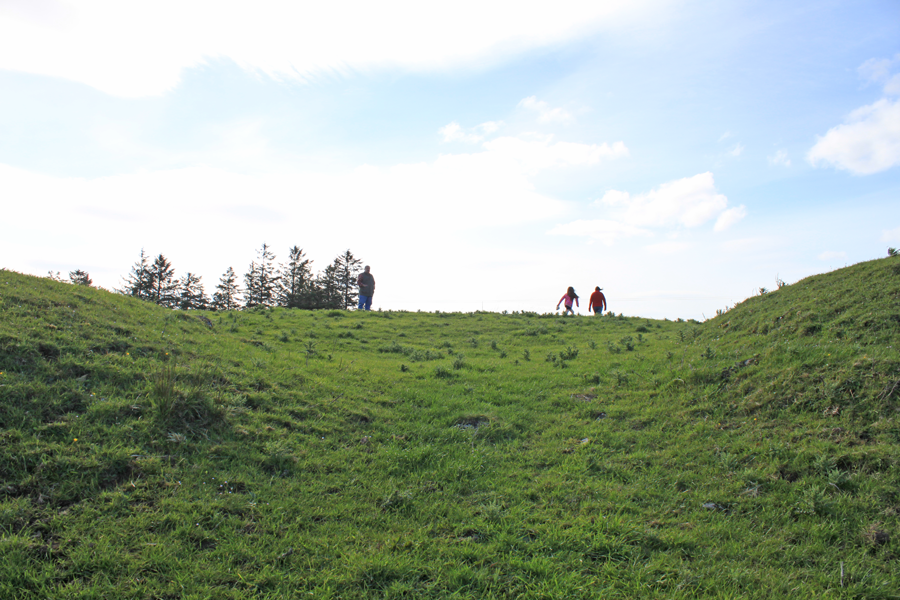 Approaching one of the Rathcroghan mounds.
Approaching one of the Rathcroghan mounds.
Over 40 years later I still wonder about that ring fort, what was it used for, why was it placed there, who lived there; my problem is that I am asking the same question about the other 140 monuments on Rathcroghan and it has taken over my life. You see Rathcroghan has the highest density of earthworks in Europe and they sit on the landscape, untouched in their original state teasing me with their enigmatic presence.
The monuments are wrapped in myths and legends, some are named after long dead kings or heroes, others hold the secrets to the otherworld, more have names associated with ancient tales and stories.
For the archaeologist Rathcroghan is a gold mine of monuments dating from as far back as the Neolithic period all the way through the bronze age, iron age, right through the medieval periods to today, so many different styles of monument – raths, cairns, barrows, ring forts, ceremonial mounds, caves and standing stones.
If you approach Rathcroghan as a spiritual pilgrim looking for a connection then you have hit the mother load. The integrity of this landscape has remained intact over the millennia as have the energies within the land. In fact the area only really makes sense when viewed as a ritual landscape.
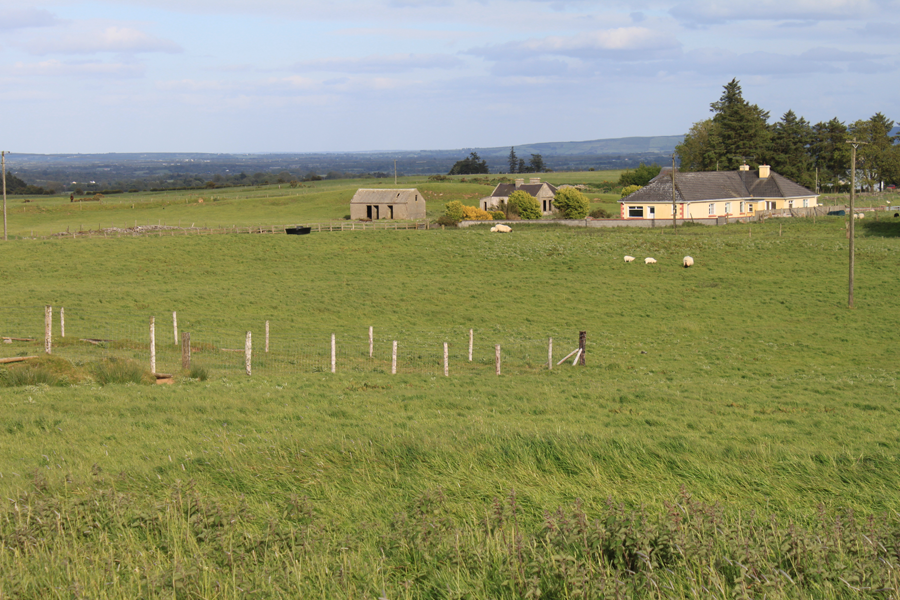 View from one of the Rathcroghan mounds
View from one of the Rathcroghan mounds
While other Celtic capitals hit the headlines and receive thousands of visitors each year Rathcroghan sits and waits for the inquisitive pilgrims to search it out, allowing only the true path walker to find it, this may sound poncy but it really is true.
The greatest thrill for me is to be able to introduce these seekers to the area and let them see for themselves just how special the area is, as I said, I’m the luckiest man in the world.
And I still love the spuds.
 Mike Croghan – Rathcroghan Tours
Mike Croghan – Rathcroghan Tours
Learn more about Rathcroghan at Mike’s website – Rathcroghan Tours. His website includes some video and audio with photographs and text. It’s a great resource for those wanting to know more about this remarkable complex of sites.
Uragh Stone Circle on the Beara Peninsula – Enchanting
The Beara Peninsula which straddles Counties Cork and Kerry has some of the most mystical sites in Ireland scattered over its terrain. The Uragh Stone Circle, not too far off the main road from Kenmare to Ardgroom is one such site. The circle has 5 small stones and one large alignment stone. Surprisingly, this stone circle doesn’t appear in guidebooks or local destination publications. I only found it due to the signage along the roadside. This site is well worth traveling thousands of miles – just for the view and the energy in the place itself.
The circle rests on a small hill that sits between two lakes – Cloonee Lough Upper and Loch Inchiquin. The back drop is of mountains, veined by waterfalls. I noticed the colors of the mountains continually change as the ever-moving sunlight shifts. The effect is similar to a kaleidoscope with muted earth tones. Stand still and watch the landscape change.
A dirt road reaches the circle, and one must cross a bridge to get to the hillock. When I was there it was damp and muddy. Traversing up the hill to the circle required boots, but well worth the challenging mud holes. Standing on the hill near the circle I could see that this was the center of the vast landscape all around. The view over Loch Inchiquin is spectacular.
This spot is magical.
The circle itself has 5 stones tangentially placed and one great alignment stone that appears to line up with the axial stone though very close in proximity. The massive alignment stone is over 10 feet high. It dwarfs every other element of the landscape.
It’s easy to imaging Uragh Stone Circle as a portal to another place or another realm. The changing light, the shifting colors, the solitary setting of the circle – all these elements consume the spirit. I lost track of time while there. After awhile a young couple walked up the dirt road from the opposite direction – past the circle. They said they’d been watching me from the hillside. I seemed so determined to reach the circle through the mud. So they came out for a walk. They were vacationing there on Beara for a week. When I asked where they were from, they replied Washington DC (just 35 miles from my home at the time).
Strange coincidences tend to occur in thin places.
